#genuinely think its a new instant classic for animated films
Explore tagged Tumblr posts
Text
Wild robot is so autistic child gets adopted by autistic mom coded and it made me WEEP
It's funny, its animation is gorgeous, and it left me in shambles but feeling whole by the end of it. Really goddamn good movie.
#wild robot#genuinely think its a new instant classic for animated films#its not a sequel or a reboot#its just a beautifully done adaptation that was executed marvelously#i think its based off of books anyway
202 notes
·
View notes
Text

BY: JILLIAN MAPES JUL 27 2020
POP/R&B
Made from afar, primarily with the National’s Aaron Dessner, Swift’s eighth album is a sweater-weather record filled with cinematic love songs and rich fictional details.
The phantom pang of missing someone before you ever meet them is an emotion worthy of its own word. That fated feeling of love and the passage of time is the theme that runs between Carly Rae Jepsen’s smash hit “Call Me Maybe” and the National’s antisocial romance “Slow Show”; it’s also the kind of thing Taylor Swift might write about. One of the loveliest tracks on folklore, the surprise album the singer-songwriter made primarily with the National’s guitarist Aaron Dessner, stands out for a strangely similar reason: a thread connecting two strangers that exists long before either realizes it’s there. “And isn’t it just so pretty to think/All along there was some/Invisible string/Tying you to me,” she sings on the delightfully plucky “invisible string,” simultaneously recalling famous lines from Jane Eyre and The Sun Also Rises.
folklore will forever be known as Taylor Swift’s “indie” album, a sweater-weather record released on a whim in the blue heat of this lonely summer, filled with cinematic love songs in search of a film soundtrack. There are those who already dislike folklore on principle, who assume it’s another calculated attempt on Swift’s part to position her career as just so (how dare she); meanwhile, fans will hold it up as tangible proof that their leader can do just about anything (also a stretch). While it’s true that folklore pushes the limits of Swift’s sound in a particular, perhaps unexpected direction, her reference points feel more like mainstream “indie” homage than innovation, taking cues from her collaborators’ work and bits of nostalgia.
At its best, folklore asserts something that has been true from the start of Swift’s career: Her biggest strength is her storytelling, her well-honed songwriting craft meeting the vivid whimsy of her imagination; the music these stories are set to is subject to change, so long as it can be rooted in these traditions. You can tell that this is what drives Swift by the way she molds her songs: cramming specific details into curious cadences, bending the lines to her will. It’s especially apparent on folklore, where the production—mostly by Dessner, with Jack Antonoff’s pop flair occasionally in the mix—is more minimal than she typically goes for. Her words rise above the sparse pianos, moody guitars, and sweeping orchestration, as quotable as ever.
After years as pop’s most reliable first-person essayist, Swift channels her distinct style into what are essentially works of fiction and autofiction, finding compelling protagonists in a rebellious heiress and a classic teenage love triangle. In “the last great american dynasty,” she tells the story of eccentric debutante Rebekah Harkness, who married into the Standard Oil family and once lived in Swift’s Rhode Island mansion, as a way to celebrate women who “have a marvelous time ruining everything.” Filled with historical details and Americana imagery, you can see the song play out in your mind like a storybook, but it also effectively makes a point about society’s treatment of brash women. Swift cleverly draws a line between Harkness and herself at the end, an idea she fleshes out in a more literal sequel, “mad woman.” Out of all the songs on folklore, “the last great american dynasty” is the all-timer, the instant classic. It sounds like the latter-day National/Taylor mashup you never knew you needed—textural and tastefully majestic, with Fitzgerald-esque lines about filling the pool with champagne instead of drinking all the wine.
With folklore’s teen heartbreak trilogy, Swift circles the same affair from each party’s differing view. “betty” is the story of 17-year-old James trying to win back his girlfriend after cheating, a familiar crime rendered new by the narrator’s genuine remorse and belief in a love regained. It has the youthful hope of a song like “Wide Open Spaces,” yet is noticeably wiser (and queerer) than the high school romances Swift wrote as an actual teenager. First single “cardigan” is told by Betty, whose disillusionment with James results in a sad, sensuous sound reminiscent of Lana Del Rey, down to the vocal style and casual lyrical quotation of another pop song. But the songs’ overlapping details and central framing device—of a cardigan forgotten and found without a second thought—are pure Swift, an instant memory portal not unlike the scarf in Red’s “All Too Well.” (The cutesy marketing angle for “cardigan” is reliably Swiftian as well.) And even though “august” is considered to be the third in the trilogy, the record’s most tender, saccharine love story plays out during “illicit affairs.” “You taught me a secret language I can’t speak with anyone else,” she sings. “And you know damn well for you I would ruin myself.” The scenes and perspectives evoked by these songs alone speak volumes about Swift’s evolution as a songwriter.
The theme of folklore is a very different way of acknowledging that people will talk, an idea that animated 2017’s trap-tinged work of minor villainy, Reputation. Swift knows her own mythology like a model knows her angles, and that’s part of what makes folklore fascinating if you maintain an open mind: a kind of reverse-engineered “mindie” project, it sonically situates her closest to Lana and chamber-pop belter Florence Welch, but may also occasionally remind you of Triple-A radio, Sufjan Stevens if he killed his more ambitious tendencies, or Big Red Machine, Dessner’s duo with Justin Vernon (see: the sparse and soulful “peace”). The album’s actual duet with Vernon, “exile,” is a little like a Bon Iver take on “Falling Slowly,” the centerpiece of the 2007 folk musical Once: awkwardly dragging until the clouds slowly part to allow something beautiful to build. Swift is playing the long game here, and while there are no wild missteps, the album could use some selective pruning (see: “seven,” “hoax”).
It’s worth pointing out that folklore isn’t a total outlier in Swift’s catalog either, or even her recent work. The tracks with Antonoff shift away from the ’80s electro-pop of 1989 and onward, but they lean into the Mazzy Star swoon of Lover’s title track, Swift’s ongoing fascination with Imogen Heap, and a twinge of the Cranberries. There are interesting images, indelible hooks, and real signs of maturity. In the dreamy “mirrorball,” Swift likens the relatability trap of fame to a disco ball, singing of fluttering on tiptoes and trying hard to make it look effortless. “august” is a great, lusty Swift summer anthem about forbidden love, where the up-close, white-hot heat of songs like “Style” or “Getaway Car” is traded for wistful reflection in the rearview. Like the rest of us, Taylor Swift knows she’s had better summers before and she’ll have better summers again. At least she’s made thoughtful use of this one.
40 notes
·
View notes
Photo
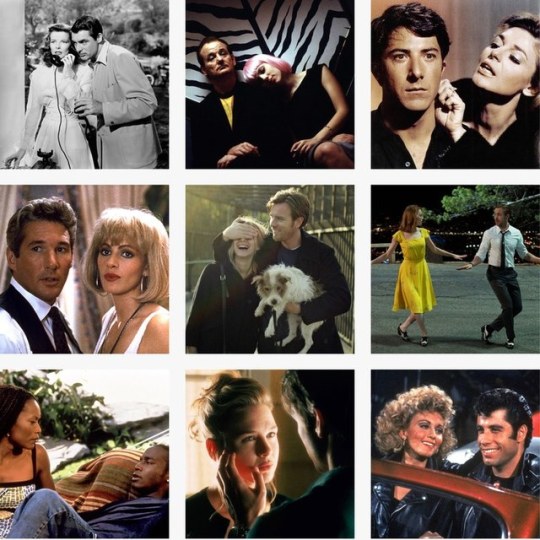
New Post has been published on http://lifehacker.guru/the-55-best-romantic-comedies-of-all-time/
The 55 Best Romantic Comedies of All Time

There is no “best” romantic comedy. Something is funny when someone laughs, or romantic when their heart swells, for better or for worse, and we have no right to say why one of these should top another. Your uncle, or cube-mate might say, “That’s stupid. Breakfast at Tiffany’s is obviously the best rom-com of all time.” And they may not be wrong. But maybe you have some reservations about the horrifyingly racist overtones in some of that movie’s scenes, even though you can’t help loving Audrey Hepburn. Maybe it’s the best for a certain time period. It’s tough. Comedy is subjective. So is romance.
It’s for this reason that we had such a good time making this list, at least initially. And lots of help. People keep a special place in their heart for romantic comedies. They talk about them differently than other movies, and they like to talk about them a lot. When the call went out, we heard from writers, editors, friends, moms, therapists, bartenders, people we hadn’t talked to since high school; the list goes on. The initial gathering of candidates was great fun; the subsequent reaping less so.
First, we had to limit the category. We love Dazed and Confused and it contains plenty of romance, and comedy, but we can’t be sure it’s a romantic comedy per se. Same with Secretary, McCabe & Mrs. Miller, My Girl, Hedwig and the Angry Inch, and about 500 other films. We don’t have enough space here to get into exactly what makes a romantic comedy, but let’s agree that the fact it is not a tragedy or a history is not enough. Somewhere we have to draw the line between the actual rom-coms and the coming of age movies, or mysteries, or adventures.
It’s for this reason we need to apologize in advance: A number of your favorite romantic comedies will not be on this list. Some of them didn’t fit the mold. Others—and this part got a little heated—we just couldn’t get on board with. Decisions had to be made. Hopefully, as a benefit to any disappointment of missing favorites, you’ll find some new ones you didn’t yet know you liked. After all, that’s the message from Pretty Woman, right? It’s important to keep an open mind. Otherwise, you could be making a big mistake, big, huge.
These are the best 55 rom-coms for every situation. We hope you love them.
The Best Rom-Com . . .
. . . to put your one-night stand in perspective:
Obvious Child (2014)
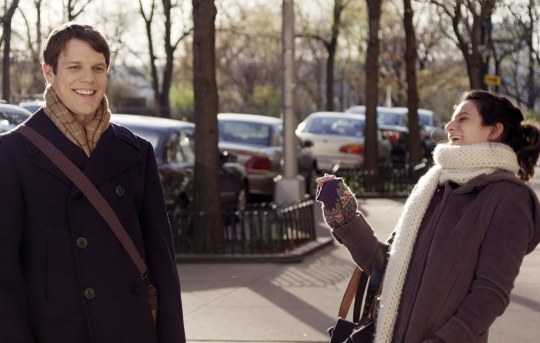
Photo: Everett Collection
The hardest you’ll ever laugh about abortion. That’s right, abortion. Talk about playing with fire, but this tender, deeply human comedy from director Gillian Robespierre finds entirely new ways into the story of losing Mr. Wrong, then Finding Mr. Right (by having our hero, a struggling comedian—played by the irrepressibly honest and infinitely endearing Jenny Slate—get drunk with Mr. Right, sleep with Mr. Right, get pregnant by Mr. Right, and then deal with the consequences). While riotously funny, Obvious Child set a new standard for intimacy, and Robespierre’s ribbed, tone-perfect writing and Slate’s raw but intelligent performance managed to shape a millennial mirror more reflective than anything Girls could put forward in six seasons. And give us the abortion comedy we didn’t know we needed.
. . . to deal with your workplace crush(es):
Broadcast News (1987)
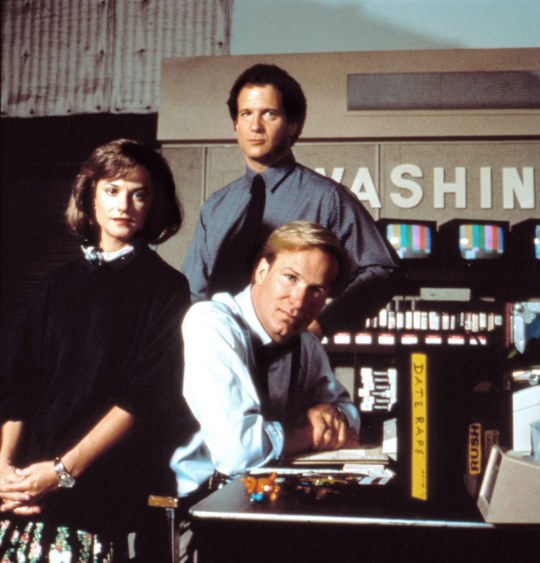
Photo: Everett Collection
In the mid to late ’80s, there was nothing bigger than TV news and James L. Brooks, and Broadcast News was their meeting ground. After the slaphappy, very silly, and very male comedies of the late ’70s and early ’80s (think Animal House, Porky’s, and Revenge of the Nerds), and alongside the epic big-budget projects like Ghostbusters and the original Indiana Jones, James L. Brooks continued to redefine what rom-coms could be with this sprawling, occasionally dramatic but never self-serious, workplace comedy. We root for Albert Brooks’s Aaron Altman, the brainy, nervous, serious journalist who competes for the affections of neurotic producer Jane Craig (Holly Hunter) against the impossibly polished (and intellectually inferior) Tom Grunick (William Hurt). Brooks is the producer behind films like Bottle Rocket, Say Anything . . ., and Big, and TV series like Mary Tyler Moore, Taxi, and The Simpsons. No one knows how to get at our hearts—thoughtfully, gracefully, and with humor—like James L. Brooks. And this is him at his peak.
. . . to see past a gruff exterior:
Beauty and the Beast (1991)

©Buena Vista Pictures/Courtesy Everett Collection
“Tale as old as time . . .” It really is. Lonely, powerful dudes have been making off with damsels and then hiding them away since at least Greek mythology and probably before. Where Disney scored with its animated musical was in—pardon the pun—reanimating that classic story line in a way that was appealing to our eyes and ears, and that of our kids’, while maintaining some real danger in the narrative. It’s a triumph they repeated with Aladdin and The Lion King, but is especially notable with a romance—making the stakes high enough—and real, even when accompanied by singing teapot—that we root for these characters to end up together.
..for when you’re in the mood for first love, Wes Anderson-style.
Moonrise Kingdom (2012)
“I will meet you in the meadow,” writes bespectacled Sam (Jared Gilman) to serious Suzy (Kara Heyward) as they prepare to run away together. Wes Anderson’s Moonrise Kingdom, a whimsical tale of a romance betwixt a pair of wise-beyond-their-years 12-year-olds (beautifully art-directed and accessorized as always), is a tonic to the jaded palate. The children, with their barely sexual, pure-hearted affection for each other, could teach the misbehaving adults around them a thing or two about love. Who wouldn’t want to dance on the beach in their underwear to Françoise Hardy?
. . . to get you over getting over your ex:
The Philadelphia Story (1940)

Courtesy Everett Collection
The credits of The Philadelphia Story read like something out of a dream: Cary Grant and Jimmy Stewart vying for the love of Katharine Hepburn. It’s produced by Joseph L. Mankiewicz (writer of All About Eve and Cleopatra), and directed by George Cukor (who made 1954’s A Star Is Born, Justine, and My Fair Lady, and once told Marilyn Monroe, “That will be just fine, darling” when, about to film a skinny-dipping scene for Something’s Got To Give, she expressed her concern that she only knew how to dog-paddle). The Philadelphia Story relies on some dependable tropes—lovers who’ve fallen out; will-they-or-won’t-they-get-back-together—that have provided romantic tension from A Midsummer Night’s Dream to Crazy, Stupid, Love. But it’s Hepburn, aiming for a comeback following some serious bombs, and her witty repartee with her two love interests, Grant (her yacht-designing reformed bad boy of an ex-husband) and Stewart (a tabloid reporter), that is the movie’s bread and butter. The Main Line has never been so well represented.
. . . to take on a trip:
Lost in Translation (2003)
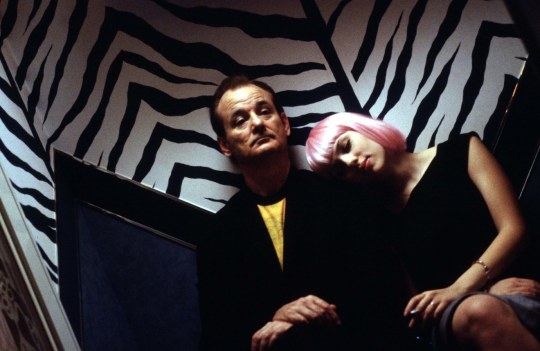
©Focus Films/Courtesy Everett Collection
There was never any doubt that Scarlett Johansson was going to be a mega star, but Sofia Coppola’s movie—about the lonely wife of a photographer who befriends an over-the-hill movie star (Bill Murray) while visiting Tokyo—is what made the world stand up and realize we were dealing with a serious actor. Like many of the films on this list, Lost in Translation takes place in a bourgeois universe, where the greatest thing at risk is someone’s heart, or future emotional happiness, but few films have so effectively crystalized the alienation of both travel and marriage, as well as the difficulties of postcollegiate, and then midlife, malaise. The older man and the younger woman don’t so much meet-cute as crash into each other, picking up each other’s pieces, redeeming each other’s lives as they navigate their surreal setting. It’s a match made in heaven—and without spoiling anything, their goodbye scene is among the best in Hollywood history.
. . . to reevaluate your checklist:
Clueless (1995)

©Paramount/Courtesy Everett Collection
The motherless daughter, caring for her father and looking for her prince, is a trope that goes back to the fairy tales, but how Alicia Silverstone (who plays our hero, Cher) and writer-director Amy Heckerling contemporized that narrative is what made what could have been a silly teen flick into an instant classic. They imported a Jane Austen story line of a meddling would-be matchmaker (Emma) into a bright pink, plastic, kids-are-adults world of Beverly Hills privilege populated by overly dramatic in-talk (“Whatever!”; “As if!”), lunatic high fashion, and decidedly un-relatable problems. At the same time, they maintained a storybook sensibility, and somehow kept our sympathies with the lovelorn Cher, whose insipidness is overshadowed by her charity, loyalty, and genuine goodwill. We believe she deserves love, and if she gets smart enough to stop looking for it in the “right” places, we want her to find it.
. . . to help you sort out what to do with the rest of your life:
The Graduate (1967)
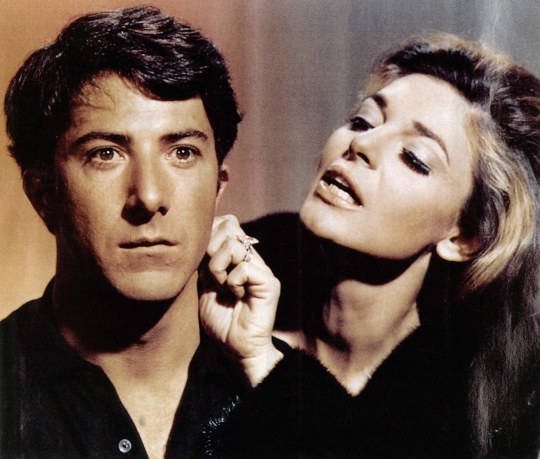
Courtesy Everett Collection
This is the film on this list that is least certainly a rom-com; it caused a bit of a row, in fact. Some of us believe that this movie is ultimately too sad to give the viewer the warm fuzzies they depend on this genre for. Others argue that this line of thinking may confuse what’s depressing with what’s complicated. The story of the listless Benjamin Braddock, recent graduate of Williams College, who begins an affair with his father’s partner’s wife, and ends up falling for her daughter, did more to advance the critical value of comedy than perhaps any other film. (Not to mention the sexual viability of Williams grads.) There may be no more iconic line than Dustin Hoffman’s “Mrs. Robinson, you’re trying to seduce” but this movie is so much more than dialogue. (Note: Hoffman might have been playing 21 when he said this line, but the actor was 29; Anne Bancroft, the supposedly senior Mrs. Robinson, was all of 35.) Oft-quoted, ripped off, referenced, and discussed, Mike Nichols’s 1967 romp through Braddock’s postcollegiate uncertainties was released a few months after the Summer of Love, as the counterculture had peaked and what Hunter S. Thompson called the “high and beautiful wave” was getting ready to roll back. Young America was, and to some extent still is, Benjamin Braddock, which reveals the power of this film.
. . . to ask for assistance in the ol’ love department:
Sleepless in Seattle (1993)

©TriStar Pictures/Courtesy Everett Collection
Tom Hanks had been responsible for some ’80s hits—Splash and Big—but with Nora Ephron’s 1993 film about a widower whose son calls in to a radio show in an attempt to find him a new wife, he cemented himself as America’s favorite, well, person. Meg Ryan, his competition for that title (at least in the ’90s), plays an unhappily engaged Baltimore Sun reporter who writes Hanks’s character on a whim, asking him to meet her at the top of the Empire State Building (cue: An Affair to Remember) on Valentine’s Day. Utterly contrived, but utterly charming, this quick, silly, funny film is pabulum superfood for anyone who believes in second chances and true love.
. . . to leave the past behind you:
Breakfast at Tiffany’s (1961)

Courtesy Everett Collection
No one has stolen more hearts than Holly Golightly (Audrey Hepburn). Based on Truman Capote’s 1958 (harsher) novella of the same name, Breakfast at Tiffany’s—the story of a friendship struck between a rarely employed writer, Paul Varjak, and his neighbor, the naïvely beautiful Golightly, a freewheeling party girl whose lifestyle is paid for by the rich suitors who surround her—is a building block of our Hollywood romantic fantasies. It has the unclassifiable, magnetic object of affection, the reliable underdog who pursues her, expectations dashed, new friendships formed, true selves discovered, and an undeniably racist portrayal of an Asian landlord (by Mickey Rooney). Yes, it was a different era, but this detail can be difficult to ignore. That said, there are generations of viewers who consider this the greatest rom-com of all time.
. . . to get past that one little (or gigantic) flaw:
Moonstruck (1987)

©MGM/Courtesy Everett Collection
Cher plays a widowed bookkeeper in Brooklyn Heights confronting her parents’ infidelity (and fallibility) who—whoops!—falls for her fiancé’s younger brother (Nicolas Cage), who sports a prosthetic wooden hand after an accident with a bread slicer. Their first night together produces one of the great moments in the annals of rom-coms: When Cage tells Cher he loves her, she slaps him, saying “Snap out of it!” The film portrays a New York that doesn’t really exist anymore—for one thing, Brooklyn Heights is full of bankers now. It’s a window to another time, when marriage meant something different in male-dominated second-generation immigrant families and the challenges Cher’s character places against the social order are both important and revelatory (she won an Oscar for her efforts). You end up cheering not just for her romance, but also for an entire insurgency.
. . . to put the fuckboys behind you:
Bridget Jones’s Diary (2001)
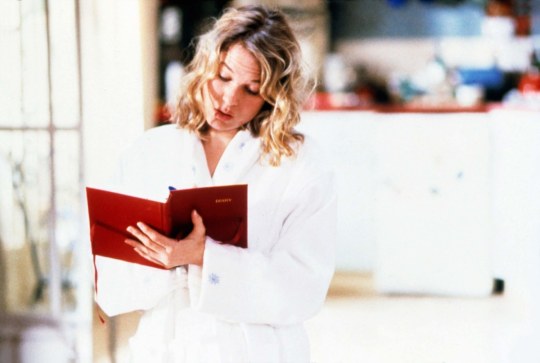
Courtesy Everett Collection
Hollywood does this silly, shitty thing when they want to make it clear that a woman is “funny”: They make her clumsy. “Did you see that? She fell down in front of the boss she has a crush on while carrying many things! What a wit!” Thankfully, this film is actually funny, and so is Renée Zellweger, the titular Bridget Jones, who is 32 and a bit clumsy, and believes herself to be both a tad overweight and running short of romantic options. She confesses to her diary her feelings about the men in her life: her caddish colleague, Daniel (Hugh Grant), and her pill of a childhood friend, Mark Darcy (if that surname sounds familiar from one of your favorite literary comedies, that’s not by coincidence), who begin vying for her hesitant affections in their respectively charmless ways. Who will win—the nice guy or the jerk? The clumsy, funny, openhearted girl, of course! The story has a classic but important lesson to share: First impressions aren’t everything (and a fashion-related takeaway—never judge a man by his Christmas sweater).
. . . to make you even more neurotic about your love life:
Annie Hall (1977)
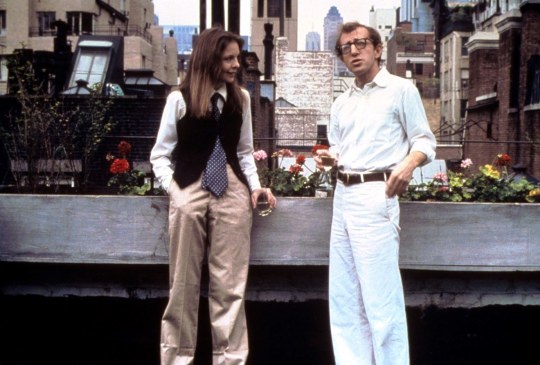
Courtesy Everett Collection
Like Breakfast at Tiffany’s, this is one of those movies that any list of top rom-coms would be remiss without. Yes, Alvy Singer’s (Woody Allen) story about how he met, and then lost, and then maybe regained, the love of his life, Annie Hall (Diane Keaton), is a wonderfully funny underdog-meets-girl story. But Allen’s uniquely observational humor also introduced some pioneering tropes and storytelling devices to the annals of rom-coms. The moment his grade school classmates stand up and give short peaks into their future (“I used to be a heroin addict; now I’m a methadone addict”). Or when Alvy interrupts a pedantic professor in a movie line—lecturing his date on Marshall McLuhan—by bringing the actual Marshall McLuhan out from behind a sign to set the man straight. These established entirely new directions for comedy. Moreover, Allen’s confessional style and the monologue with which he begins telling his warts-and-all fictional tale established a new paradigm for romantic storytelling, one that continues to influence rom-coms today (same for Diane Keaton’s outfits, but that’s a topic for another list).
. . . to get you pumped up:
Bring It On (2000)

©Universal/Courtesy Everett Collection
This is the pregame of romantic comedies. It’s a love story—between millennial hotties Kirsten Dunst and Jesse Bradford—packed into 98 minutes of jokes, rivalries, teen romance, and ridiculous cheers. (“Hate us ’cause we’re beautiful—well, we don’t like you either. We’re cheerleaders. We. Are. Cheerleaders!”) Some of us have defended this movie since it bowed (and then cartwheeled into an aerial walkover) in 2000 as a sharp appreciation of teen culture and teen cinema, both devoid of cynicism and long on wordplay. If you agree, welcome to the squad. If not, please keep in mind, “This is not a democracy; it’s a cheer-ocracy.”
. . . to take an break from yourself:
Roman Holiday (1953)

Courtesy Everett Collection
There’s a wonderful moment in Roman Holiday—the story of a European princess, played by Audrey Hepburn, who tires of her duties and runs away from her handlers while visiting Rome—when Joe (Gregory Peck), a reporter showing her the city, puts his arm in the Mouth of Truth (a statue that supposedly bites off the hand of liars) and removes it with his hand missing. The princess screams—Hepburn was apparently not acting here—and then recovers. It’s a metaphoric yawp for all that a romantic comedy should be. It’s being taken by surprise, taken by a stranger, the discovery a new side of oneself while falling for someone else. And that’s just one moment!
. . . to get him into rom-coms:
The Princess Bride (1987)
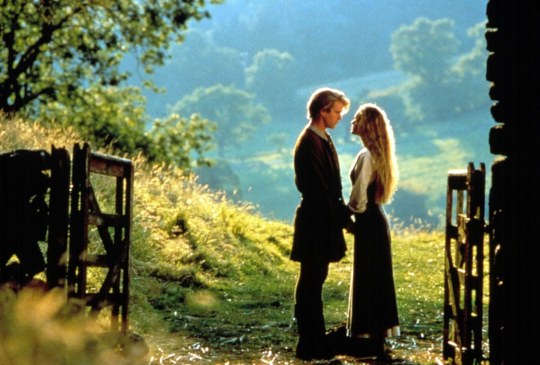
©20thCentFox/Courtesy Everett Collection
“Is this a kissing book?” Fred Savage’s little boy asks his grandfather, at his bedside to read him The Princess Bride when he’s home sick from school. Sure is, but it’s also a tale of swashbuckling, cruel kings, giants, swordsmen, poison, monsters, rebels, and knights—without a dull or unfunny moment. The kid, and the viewer, is quickly on board. More than anything, it’s a tale of true love, and fantastic as it might be, the adventure that leads the stable boy, Westley, back to his mistress, Buttercup (played by an impossibly beautiful Robin Wright), has left few hearts unmoved, and few faces without with smiles.
. . . to consider what you could have done differently:
Groundhog Day (1993)

©Columbia Pictures/Courtesy Everett Collection
One of the few rom-coms that comes with both a stamp of approval from your philosophy professor and the Tony reaches of Broadway. A cynical Pittsburgh weatherman (Bill Murray) is sent to Punxsutawney, Pennsylvania, with his producer, Rita (Andie MacDowell) on a dead-end assignment: to cover Groundhog Day. And boy, is it a dead end. Murray gets stuck there, not just in a snowstorm, mind you, but in a continuous loop where no matter what he does—including suicide—he wakes up in the same hotel, on the same day. At first, the weatherman is predictably bummed, but eventually he uses all the information he’s picked up living the same day over and over to better himself and the lives of those around him, eventually impressing Rita with his change of personality. Watching Bill Murray is fun, watching Bill Murray struggle is really fun, and watching Bill Murray caught in a space-time logjam, wrestling with moral philosophy while pursuing Andie MacDowell is the most fun.
. . . to find “our song”:
Nick and Norah’s Infinite Playlist (2008)
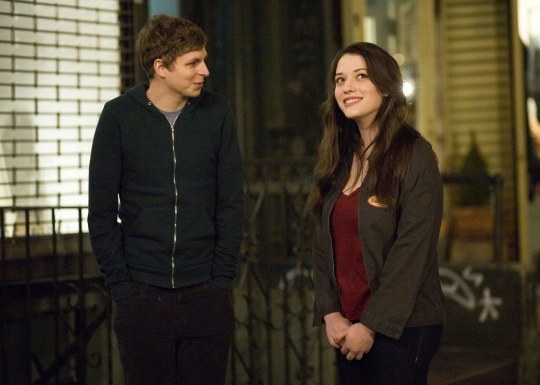
Entertainment Pictures / Alamy Stock Photo
There’s something almost quaint about Norah’s search for her orgasm. The high schooler, played by Kat Dennings, is demeaned by her fellow classmates for having yet to experience the big O. It may sound tawdry, yet this plot point harkens back to a sweeter, John Hughes–era teen comedy (with a few switches flipped) wherein the search for a simple sex act was enough motivation for a number of scenes, if not an entire film. Norah’s lack of fulfillment isn’t what moves the action here; instead we’re on a search for her best friend and an oh-so-cool band’s secret show, with Nick’s (Michael Cera) hapless band, in his hapless car (a Yugo), through downtown New York City’s music scene. It’s a good-time flick, with cheerful performances and the kind of supporting cast (Ari Graynor as the beyond-drunk best friend) that make 90 minutes seem like a brisk 30. One of these is Alexis Dziena, who plays Nick’s very recent ex-girlfriend: She toyed with him and never appreciated the music mixes he made for her (spoiler: Norah loves them). Her “sexy” dance, in the glaring light of Nick’s high beams, to Hot Chocolate’s “You Sexy Thing” is one of the great falls from grace, and worth the price of admission.
. . . to inspire some big changes:
Pretty Woman (1990)

©Buena Vista Pictures/Courtesy Everett Collection
Is there a rom-com list that doesn’t include this movie? What’s left to say about the 1990 tale of the beautiful, charming prostitute and the Wall Street corporate raider who meet and fall in love? Here’s director Garry Marshall’s (and Julia Roberts and Richard Gere’s) genius with this film: They make us forget about the various horrors of sex work and instead convince us the whole thing is kind of a lark. This film takes place in the late 1980s; a high-water mark in terms of the HIV crisis. Those things aren’t on our minds when we watch this movie (barring an early scene discussing methods of birth control); we think about stomping divots and Richard Gere conquering his fear of heights. So what? The Great Escape doesn’t exactly feature the horrors of World War II. That’s not the story they’re telling. Exactly our point. That’s how delightful this movie is.
. . . to make your arguments a little sweeter:
Bringing Up Baby (1938)

Courtesy Everett Collection
Here’s how cute rom-coms were in the 1930s: The entire plot rests on a dog burying a bone of a brontosaurus. Katharine Hepburn, whom the movie was written for, plays a whimsical, adorable socialite who has become besotted with an otherwise engaged (literally and figuratively) paleontologist, played by Cary Grant, and is trying to keep him around so he won’t go marry some pill. Her strategy for doing this is to invite him to her house so that he can help her bring a baby leopard to the city. (Later, the dog and the leopard wrestle.) This is what we call a screwball comedy. It’s also priceless, with Hepburn peppering Grant in her sweet, Gatling gun style, and Grant, playing stiff, as if any man, never mind a mild-mannered paleontologist, could ever resist such wiles.
. . . to make it a girls night:
10 Things I Hate About You (1999)
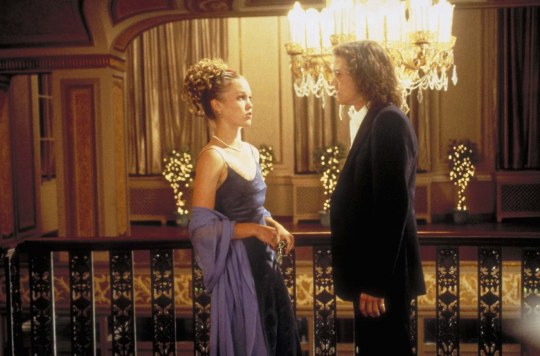
©Buena Vista Pictures/Courtesy Everett Collection
Why is there no actual Shakespeare on this list? Because often a three-hour production: (1) is rarely funny, and (2) doesn’t really fit into a modern romantic comedy structure. Instead, we have movies that are actually fun to watch, like Shakespeare in Love, and this one, a teen-ready take on The Taming of the Shrew. There are some cute turns from youngsters Joseph Gordon-Levitt, Julia Stiles, and Larisa Oleynik, but ask most women and the performance that sticks out is Heath Ledger’s, whose thuggish Patrick Verona made many of us weak in the knees. Like Bring It On, and unlike most films, especially teen films, this one is female focused. They’re the moral centers. The heroes we cheer for. And they are active in as much as the narrative as they are subject to it (rare!).
. . . to better understand your parents:
Beginners (2011)

©Focus Features/Courtesy Everett Collection
“The History of Sadness” is a sketchbook drawn by Ewan McGregor’s Oliver, a graphic designer who is dealing with the recent coming out of his septuagenarian father, Hal (Christopher Plummer—who won an Oscar for his performance). Hal’s new openness about his own life inspires Oliver to reevaluate his own sadness and pursue a lovely French actress, Anna. It’s an incredibly touching, difficult story, told mostly in flashback, that involves Oliver coming to grips with his father’s past, his parents’ relationship, his own choices, and his art. But it’s ultimately a love story. A story about how our parents love us, and each other—despite the difficulties imposed society, time, and work—and how in turn, we learn to love, or not. We’re all beginners, in all our loves, and to think otherwise is foolhardy.
. . . to freeze some already cold feet:
The Wedding Singer (1998)

©New Line Cinema/Courtesy Everett Collection
Millennials might not realize from Adam Sandler’s recent descent into perennial schlock (some of it racist and sexist)—like The Ridiculous 6, Blended, Jack and Jill, and Grown Ups—that his movies were, at one point, very funny. Billy Madisonand Happy Gilmore are ’90s classics, and The Wedding Singer, his only rom-com from that era (there’s some debate over whether P. T. Anderson’s Punch-Drunk Love, released in 2002, qualifies as such), is a hilarious, touching ode to traditional values. Set in the ’80s, Sandler’s Robbie Hart is a wedding singer (and hopeless romantic) recently left at the altar who helps Drew Barrymore’s Julia plan her wedding to the wrong man. Sandler and Barrymore’s chemistry is off the charts, and this film—not Mad Love, sorry—established the actress as rom-com gold (see Never Been Kissed, 50 First Dates, and Fever Pitch). The romance is great, the jokes are great, the costumes are great, and not to ruin anything, but Billy Idol is pretty great too.
. . . to get you singing and dancing (and maybe moving to L.A.):
La La Land (2016)

©Lions Gate/Courtesy Everett Collection
The highway scene. Ryan Gosling hunkered over the piano. Emma Stone embodying “irrepressible.” His dance on the boardwalk. Her spins. The way she pulls at her dress. The way he grins while he smolders. Their love. It’s a panacea for the reasons we go to the movies. At no point do we believe they won’t end up together, but we stay transfixed, in fact we tap along. For younger viewers—those of us who might not have drank down the moving magic of Singin’ in the Rain, West Side Story, or Gigi—Damien Chazelle’s La La Land forgives those lapses. It embraces their greatness as it embraces us in its giant, vibrant arms. We lean closer to the screen, not to learn but to feel for the whole experience of youth and performance: all that hope, drive, sweat, and love. Can’t forget love.
. . . to kick-start your career goals:
Singin’ in the Rain (1952)
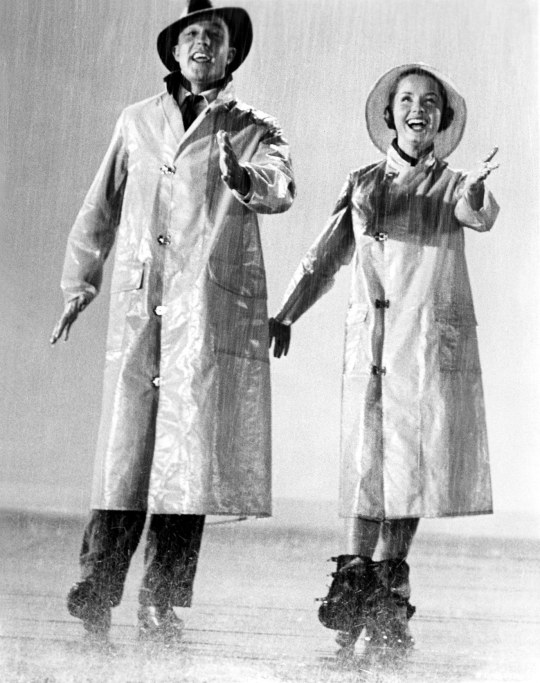
Courtesy Everett Collection
Here’s the thing: You’re not really allowed to like La La Land if you don’t like Singin’ in the Rain. Or, you at least have to watch it; it’s the original musical about making it in Hollywood. The story of a sellout leading man (Gene Kelly) who falls for the chorus girl (Debbie Reynolds) who might just change his life (and he hers), this 1950s romp through 1920s Hollywood really has it all: singing, dancing, and bedrock songs like “Make ’Em Laugh,” “Good Morning,” and of course, “Singin’ in the Rain.” It’s cute as hell and tap-happy to the extreme.
. . . to unplug from the office (and get your due):
How Stella Got Her Groove Back (1998)
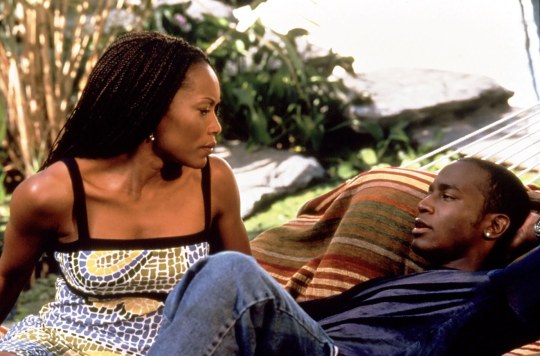
©20thCentFox/Courtesy Everett Collection
The movie that inspired 90 percent of vacation hookup jokes since 1998 (but seriously, we need to talk about Taye Diggs in a puka shell necklace; the man can make anything look good). Workaholic executive and single mom Stella (Angela Bassett) finds more than she bargains for when her best friend, played by Whoopi Goldberg, convinces her to take a much-deserved Caribbean vacation. Cheeky, subversive, and sexy as hell, this movie turned the tables on so many male-dominated rom-coms (courtesy of one very hot and heavy matchup between Bassett and Diggs, playing some 20 years her junior)—and passes the Bechdel test with flying colors. One of the very few rom-coms to do so.
. . . to get dressed up for:
Tootsie (1982)
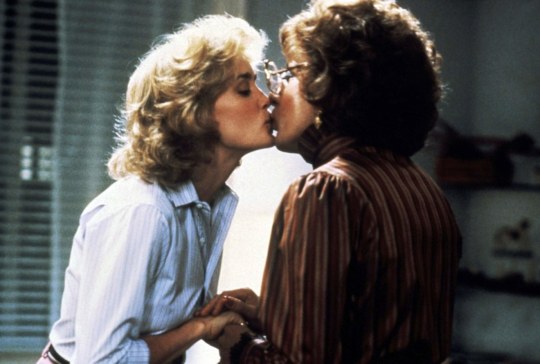
©Columbia Pictures/Courtesy Everett Collection
Michael Dorsey (Dustin Hoffman) is a New York actor who is such a perfectionist, no one wants to work with him. So he does what any rational man would do: He dresses as an entirely different person—an older woman who goes by then name of Tootsie—and lands a role on a soap opera where he becomes a sensation. Problems arise when he falls in love with his costar (Jessica Lange) and a fellow castmate, an older man, falls in love with him. It’s madcap and zany but also profoundly funny, with insights aplenty—it sends up television, sexism, and New York society—and performances that were Oscar-worthy (Lange’s in particular—of Tootsie’s 10 Oscar nominations, she’s the only one who walked away with a statue).
. . . to reevaluate the nice guy (and the bad boy):
Something Wild (1986)

©Orion Pictures Corp/Courtesy Everett Collection
Before Johnathan Demme decided to win an Oscar and scare the pants off an entire generation with The Silence of the Lambs, he was an ’80s funnyman. And this is his best work. It’s the story of a mild-mannered exec (played by Jeff Daniels), whose sedentary life is turned upside down by the wildly adventurous, somewhat grifting Lulu (Melanie Griffith)—whose checkered past includes a roustabout, criminal ex-boyfriend played by Ray Liotta. The idea of a “crazy” girl coming in and turning a straight man’s existence topsy-turvy is repeated countless times in this genre, from Bringing Up Baby to The Girl Next Door. Demme’s alchemy here is to infuse the trope with unpredictability. The comedy keeps us on the edge of our seats by compounding the will-they-won’t-they question with sudden breaks into violence, threats, or chase. Rom-coms don’t get more exciting than this.
. . . to escape it all:
Midnight in Paris (2011)
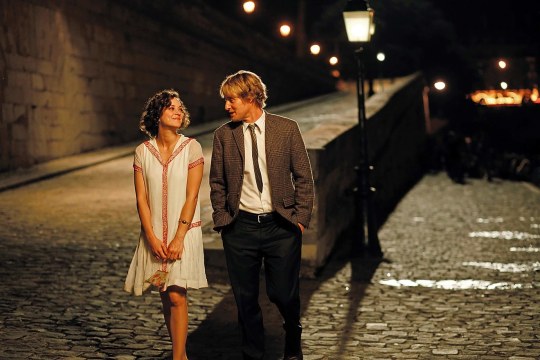
Sony Pictures Classics/courtesy Everett Collection
The love story here is as much between writer-flaneur Gil Pender and Paris as it is between Gil and any of the women in this film. While visiting the French capital with his uptight fiancée, Inez (a sublime Rachel McAdams), and her parents, each night Gil goes walking and finds himself in the City of Light of the 1920s, complete with Hemingway, Gertrude Stein, the Fitzgeralds, Man Ray, Josephine Baker, Cole Porter . . . and a beautiful woman named Adriana (Marion Cotillard). It’s a writer’s fantasy made real (Stein volunteers to read his novel), but it’s also Woody Allen at his most effective: taking the vicissitudes of relationships and turning them into a mirthful, if neurotic, journey. This one just happens to also navigate through another time and place as well. And a beautiful one, at that. There’s a reason this is Allen’s highest-grossing film of all time.
. . . to escape the friend zone:
When Harry Met Sally. . . (1989)
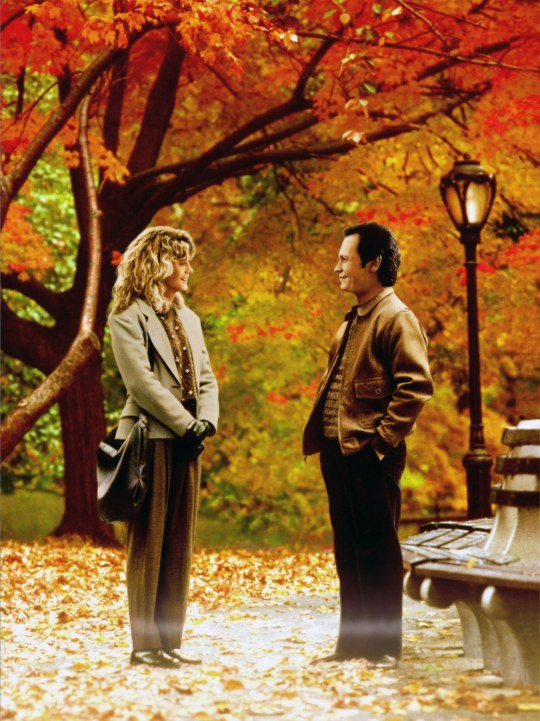
©Columbia Pictures/Courtesy Everett Collection
If this list were a top 20 instead, this film would still be on it. Same with top 10—and five. It’s in the running for the best rom-com of all time because it is sassy, sultry, snappy, cinematic perfection, thanks to words from Nora Ephron and direction from Rob Reiner. It’s something of an epic of the genre, spanning over 10 years of the kind of friendship (between Meg Ryan and Billy Crystal’s characters) where no one can help but ask, “Why aren’t those two together?” Should friends ever sleep together? If they do, what happens next? This movie should be watched by every college student on the planet. Bonus: Watch this movie with a boyfriend, and pay attention to what happens to his face during Meg Ryan’s most famous scene, in which she illustrates just how easy it is for a woman to fake an orgasm.
. . . to unite with your crew:
Bridesmaids (2011)
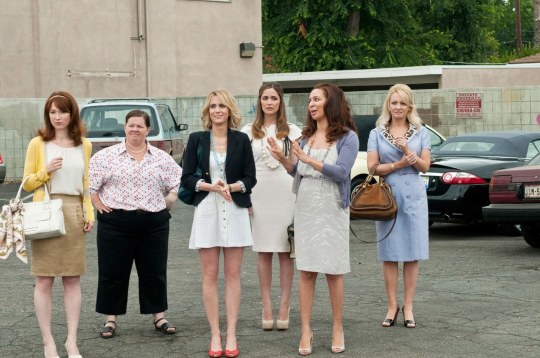
©Universal/Courtesy Everett Collection
Who ever thought getting food poisoning in a wedding dress could be so funny? Bridesmaids is as much a buddy comedy (think Old School or Twins) as it is a rom-com, proving that female actors can be just as bawdy and into gross-out humor as their male counterparts in The Hangover. This is about the love between friends, yes, and the agony that comes with maturing at different paces, but what ultimately drives the film is the desire of Annie (Kristen Wiig, who also wrote the script, with Annie Mumolo) to catch up. This movie isn’t as much about what we have as about what we’re missing, and how a wedding can bring that to the fore. Along with nonstop laughs, we get a powerhouse performance from Wiig—even as Melissa McCarthy steals the show.
. . . to remind you that guys will try anything:
There’s Something About Mary (1998)

©20thCentFox/Courtesy Everett Collection
Before we had a president who bragged openly about grabbing women “by the pussy”, this is what qualified as a gross-out film. Amid scenes of semen being used as hair gel and testicles jammed in zippers, the Farrelly Brothers managed to concoct an amiable story about a nerdy Ted (Ben Stiller) hiring a private detective to find Mary (Cameron Diaz), the object of his unrequited love in high school. Despite the over-the-top locker-room gags, the movie has virtually no sex, and manages to emerge as hilarious, sweet, and satisfying.
. . . to make up your mind, dammit:
Manhattan (1979)

©United Artists/Courtesy Everett Collection
Elephant in the room: Yes, this is Woody Allen pursuing a high school student (a luminous Mariel Hemingway). It was also made in 1979, and that didn’t carry quite the same connotations as it does now. The year is important, because as the film’s title suggests, this movie is as much about New York as it is about the lovers who collide inside of it (Allen’s character, Isaac, begins the film dating the high schooler, but leaves her for his friend’s mistress, played by Diane Keaton). In the mid-to-late 1970s, New York was a bit of a cesspool: Crime was out of control, repeated requests for federal aid were denied, and the city was on the edge of bankruptcy. It’s in the wake of this tumult that Allen pens his black-and-white love note to his fair city. The film opens with a montage of New York’s skyline and street scenes, revealed to “Rhapsody in Blue,” and Allen’s voice-over as Isaac, writing about his romantic love for the city. That’s where he gets us with this film; Allen crystalizes the outsize feelings that can swell with romance, despite any and all evidence that should temper them. It’s a movie about indecision, bad choices, and falling for the wrong people, but it celebrates the impetus for all of these. We love the things we shouldn’t. That’s life. That’s Manhattan.
. . . to know if he’s worth the trouble:
Say Anything. . . (1989)

Photo: Courtesy of © 20th Century Fox Film Corp./Everett Collection
If for no other reason, you need to see this movie so you’ll understand what it means when someone holds a ghetto blaster over his head outside the window of the woman he loves. Like most of the teen romance flicks on this list, Say Anything. . . doesn’t end at the Big Dance. This movie, from director Cameron Crowe (and produced by James L. Brooks) is far too sophisticated for such a middling finale. It’s too busy diving into the angsty, all-consuming, awkward challenge that is young love, as embodied by consummate underdog Lloyd Dobler and his attempts to woo the beautiful valedictorian Diane Court.
. . . to get him back:
Crazy, Stupid, Love. (2011)

©Warner Bros/Courtesy Everett Collection
If The 40-Year-Old Virgin was evidence that Steve Carell could be a romantic lead, this was the proof. Alongside Julianne Moore, as the cheating wife he wants to win back, and with Ryan Gosling, who plays his cad coach, as well with a terrific performance from a teenage son who loves his babysitter, who in turn loves his nice-guy dad, Carell is well matched. Throw in Kevin Bacon as a romantic rival and Emma Stone as a law student just out of Gosling’s reach, and we’re ready to go. It’s a comedy that’s as much about accepting the facts of life—be they middle age, the people we can’t have, or the people we don’t want others involved with—as much as it is about a pursuit, or any one relationship. It’s about how love really is, sometimes, which can be romantic in its own right.
. . . to fall in love with literature:
Shakespeare in Love (1998)
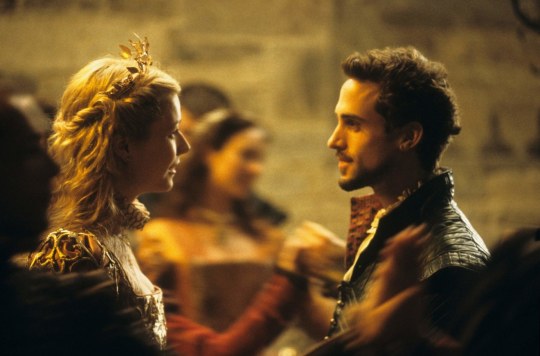
©Miramax/Courtesy Everett Collection
People forget about the competition Shakespeare faced, and we don’t mean the other plays. In the late 1500s, one could go to the theater, or one could go watch some people be executed or a bear be torn apart by dogs. That’s how entertaining Shakespeare’s work had to be! In 1998, this film competed with Saving Private Ryan, Elizabeth, and Life Is Beautiful for Best Picture and managed to come out with the Oscar. What drew the academy to the fast-paced mash-up of Romeo and Juliet with a very loosely interpreted history of William Shakespeare’s life was the film’s ability to capture exactly what Shakespeare did back in his day: the urgency of love and the power of its expression—its ability to consume us and change lives.
. . . to tell your real friends from the sham ones:
Muriel’s Wedding (1994)
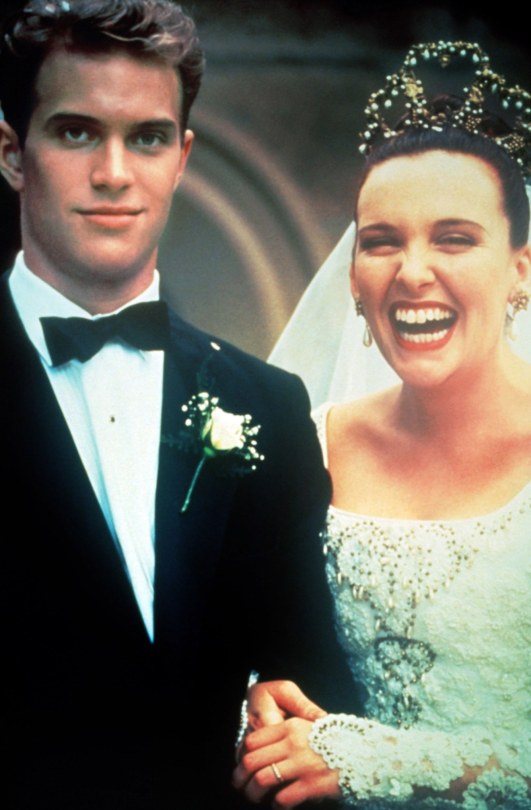
Everett Collection (13649)
Muriel (Toni Collette), a daydreamer and the target of the bitchy girls she considers her friends, wants nothing more than to get out of her small town and away from her awful father, move to Sydney, and get married. When she makes off with her parents’ savings, reunites with a fellow outcast from her town, and is offered the chance to marry a gorgeous South African swimmer who needs a visa, she can make her dreams come true. As much of a coming-of-age story as a rom-com (Muriel may be in her 20s, but she has much growing up to do), this film does a brilliant job of cutting the legs out from underneath our expectations by giving us exactly what we’ve always wanted, and tying us up in the strings attached.
. . . to relive high school (or what you wish high school was like):
To All the Boys I’ve Loved Before (2018)
Netflix’s most popular entry into the rom-com genre (based on the novel by Jenny Han) was for many an instant classic—not least for blessing the world with Peter Kavinsky (Noah Centineo), the Jake Ryan of the Internet era. Lana Condor stars as Lara Jean, a quiet high school kid who relieves her romantic pressures by writing never-to-be-mailed love letters to the objects of her affection—including her older sister’s ex-boyfriend. Until, of course, one night they get sent out. Hijinks—and a fake turned not-so-fake relationship—ensue.
. . . to remind you how much better it gets after high school:
American Pie (1999)
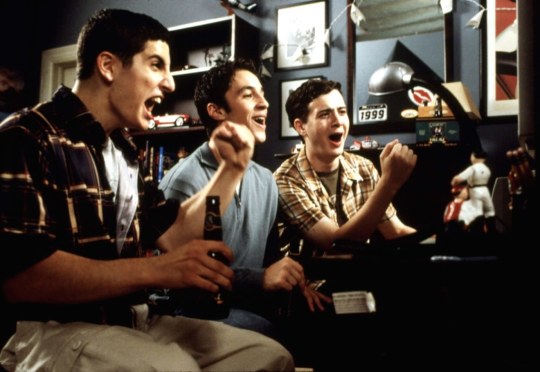
©Universal/Courtesy Everett Collection
A teen sex comedy with a heart of gold, this story of four high school friends determined to have sex before they graduate was the surprise hit of 1999. But underneath all the masturbating with pastry and accidentally ingested semen cocktails, there’s real sentiment to the adolescent boys trying to find their way with women, and vice versa. The reason we can safely call this a rom-com is that, while it doesn’t exactly pass the Bechdel test with flying colors, the objects of the guys’ affections are far from just objects. They have goals of their own we’re brought on board with. The girls aren’t just out for the boys, they’re out for themselves—as disappointingly rare in a rom-com as it is in a teen comedy, and the reason we love this one.
. . . to learn how far to take it:
Rushmore (1927)
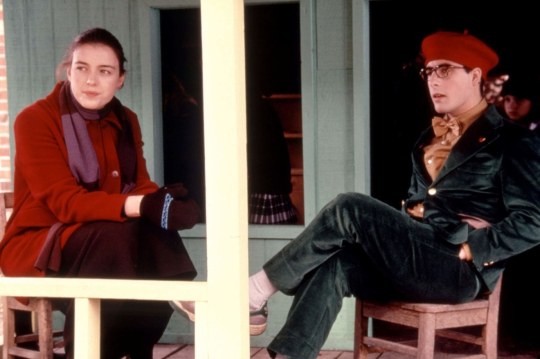
©Buena Vista Pictures/Courtesy Everett Collection
This is Wes Anderson’s most completely stylish movie, and perhaps his best, made before stylized fuckery got in the way of things like writing (like all his best work, this was cowritten with Owen Wilson). Max Fischer (Jason Schwartzman) is a scholarship student at a private school. His academics are dismal, but he’s game for any and all extracurriculars, especially the over-the-top plays he produces and directs. He gets into a contest for the affections of a widowed first grade teacher with local industrialist, and his newfound mentor, Herman Blume (Bill Murray). Several phenomenal executions come together in this film, including the ensemble cast, the just-on-this-side of believable production design, and an absolutely killer classic rock soundtrack. But what pushes it above the rest is the utter drive of both Max and Herman, as love and competition gains primacy over every aspect of their lives. They’re both willing to burn the village to save it, which is simultaneously hilarious to watch and cathartic to anyone who’s ever had a crush.
. . . to locate your other half:
Jerry Maguire (1996)
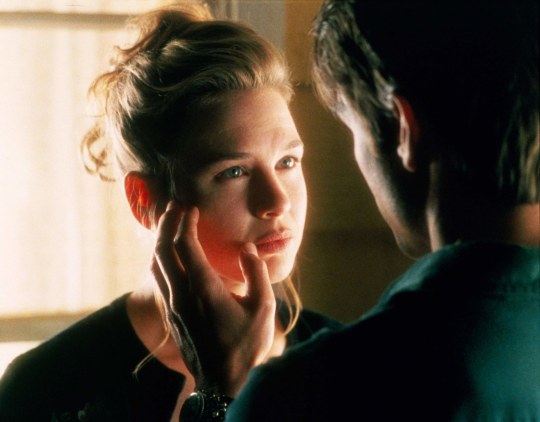
©TriStar Pictures/Courtesy Everett Collection
Cameron Crowe has a couple of films on this list (Almost Famous was close, but ultimately more coming-of-age than comedy) with good reason: He understands people and how they tick. Despite its memorably demonstrative, over-the-top lines, like “You complete me,” and “Show me the money,” this is ultimately a movie about how people really fall in love. Sure, Renée Zellweger loves Tom Cruise from the beginning—it’s a movie after all, and he is Tom Cruise—but what Jerry Maguire gets to is what happens after that first kiss, after the honeymoon period, when we have to learn about the other person as a person, and not just see them and their adorable puppy (or in this case, an adorable son, played by Jonathan Lipnicki) as an escape or alternative from our own lives.
. . . for a dose of realism (and Paris!)
Two Days in Paris (2007)
For sheer hilarious, messy, complicated realism, Two Days in Paris takes the prize. The brilliant and surprising Julie Delpy writes, directs, and stars as Marion, a young Frenchwoman who has brought her American boyfriend Jack (Adam Goldberg) to her hometown en route from a trip to Venice. They struggle through misunderstandings, language barriers, cultural clashes, encounters with Marion’s many ex-boyfriends, and her unruly parents (played by Delpy’s real-life mother and father, actors Marie Pillet and Albert Delpy,) and barely come out the other side. The moral, as Marion paraphrases Jack: “It’s not easy being in a relationship, much less to truly know the other one and accept them as they are with all their flaws and baggage.” It may not be easy, but it’s highly entertaining to watch them try.
. . . to get you through the holidays:
Love Actually (2003)

©Universal/Courtesy Everett Collection
Is this? Not really. But that’s not why we go to the movies. Love Actually is, actually, a rather clichéd Christmas rom-com, but jeez, we love it anyway. How can we not, with this ensemble cast of British romance all-stars (Hugh Grant, Emma Thompson, Liam Neeson, Colin Firth, and Keira Knightley, among others)? The prime minister (Grant) falling for a junior staff member? A quiet suitor in love with the new bride (Knightley) of his best bud (Chiwetel Ejiofor), who is apparently one of three people of color in London? A cuckolded boyfriend (Firth) rebuilding his shattered life with the help of his shy housekeeper? Balderdash. All of it. But it’s irresistible. Come on, what are you, made of stone?
. . . to fall for his funny bone:
Top Five (2014)
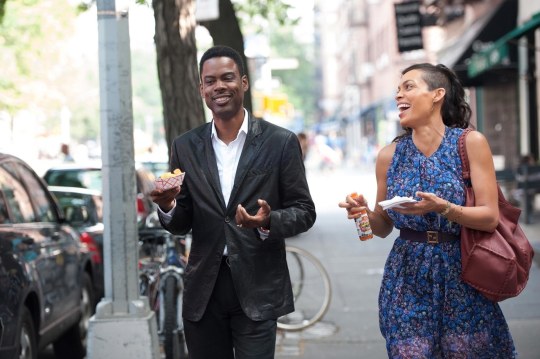
©Paramount/Courtesy Everett Collection
Think of it as Before Sunset meets Funny People, with New York taking the place of Paris. If that notion produces a little eye roll, get those peepers back down, and then on to the screen before you miss some laughs. Rosario Dawson plays a New York Times journalist tasked with interviewing a hugely famous comedian, played by Chris Rock, who is attempting to take his career in a new direction (courtesy of an ill-advised serious film about a Haitian revolutionary). Like Roman Holidaybefore it, this is a film rooted in our society’s placement of, and expectations for, certain figures (a celebrity and a princess, respectively). In both cases, the journalist finds the human being inside of their famous subject, falling for them while trying not to fall for their shtick, or what they represent. As the pair make their way through Manhattan—with visits from Jerry Seinfeld, radio hosts Opie and Anthony, Whoopi Goldberg, and a fantastic supporting job from the ageless Gabrielle Union, playing a reality TV starlet—we can’t help but get on board with their journey.
. . . to look past his neurotic, potentially mentally ill exterior:
As Good as It Gets (1997)
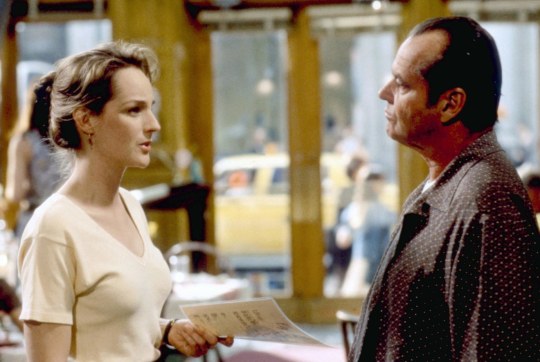
©Sony Pictures/Courtesy Everett Collection
There are few actors who can go toe-to-toe with Jack Nicholson. Director James L. Brooks found a suitable sparring partner with Shirley MacLaine in Terms of Endearment and struck gold again nearly 15 years later with Helen Hunt. Hunt plays a waitress with a sick child for whom Nicholson—a mean, racist, homophobic, obsessive-compulsive writer and her regular customer in the restaurant where she waits tables—has some affection. Bring in Nicholson’s neighbor, a gay artist (played by Greg Kinnear) who has to lean on the Nicholson’s character for help (beginning with care for his adorable dog), add a road trip, and you’ve got yourself one of the most delightful, well-thought-out comedies of the ’90s. The movie takes it time, but it’s to our benefit—Brooks allows us to get to know each of these people, and them each other, intimately, which means when the jokes, and the romance, land, they land hard, and then stay around. (Plus, who among us could resist Nicholson growling, “You make me wanna be a better man”?)
. . . to confirm that, yeah, he’s probably cheating:
Shampoo (1975)

Courtesy Everett Collection
There’s a lot going on in Shampoo—the story of an L.A. hairdresser (Warren Beatty) who is sleeping with, well, everyone (including Julie Christie, who plays a prime target of his affections)—which, at first glance, could just be another ’70s sex comedy. Keep in mind, it’s directed by Hal Ashby, the king of thoughtful, offbeat romances, and was both written by and featured, Warren Beatty, a major voice of the Hollywood Left in the 1970s. The film, released a year after Nixon’s downfall, takes place during on the eve of Nixon’s election in 1968, so there’s a good deal of interplay between the politics and the sexual politics that were in the air as the counterculture died, the pill became mainstream, and the country saw itself in a whole new, darker light. That said, Beatty’s portrayal of the harried, discursive, libidinous George is irresistible even without context, as is the performance given by a young Goldie Hawn, who illuminates every frame—and perfectly counteracts Beatty—with blonde California light, and a heart-melting, downy innocence.
. . . to get you on board with AI:
WALL-E (2008)

©Walt Disney Co./Courtesy Everett Collection
There are more epic Disney romances (one of them is on this list), but none more thoughtful. What we love about this futuristic tale of a little trash compactor, WALL-E, who falls in love with his technological better, EVE, is the considered environmental, anti-consumerist message that suffuses the dystopian love story. With barely a word, only whirrs, between them, EVE and WALL-E convincingly fall in love. His efforts to save her, once the megacorporation Buy-n-Large (their maker) comes for her, is as authentic as Hawkeye’s return for Cora, or Jack’s sacrifice for Rose. Forget Finding Nemo, this is writer-director Andrew Stanton’s Pixar masterpiece.
. . . to justify your May-December romance:
Harold and Maude (1971)

Courtesy Everett Collection
There’s a question that lingers throughout most of Harold and Maude—the story of a death-obsessed young man (he enjoys driving a hearse, attending funerals, and faking his suicide) who falls for a much, much older woman—are these two going to get it on? It sounds sophomoric, but it’s actually essential. Harold and Maude are separated by approximately 60 years; for the movie to hit home, for us to believe that love is truly about what we share, not what we look like or other aesthetic values, we have to believe a genuine attraction has formed. No one prodded existentialism (especially in films deemed “romantic”) like director Hal Ashby, and Harold and Maude is no exception. The darkly funny tale will leave you questioning just what is important to you in your own conception of love—and, moreover, in your life.
. . . to give comic books their due:
Chasing Amy (1997)
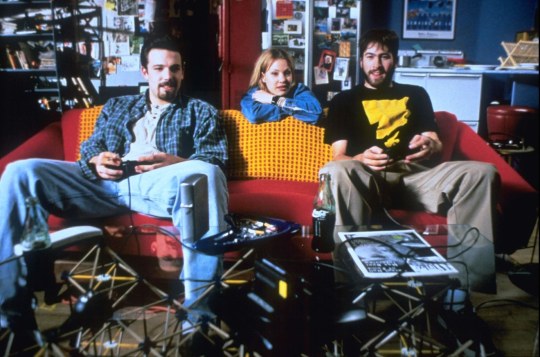
©Miramax/Courtesy Everett Collection
A comic book artist (Ben Affleck) with an inseparable best friend (Jason Lee) falls for a beautiful gay girl (Joey Lauren Adams)—who then falls for him—only to discover he can’t handle it. Comic books? Lesbian conversion? Best buds? Sounds like a romantic comedy made by men, for men. And it is! But Kevin Smith also managed a somewhat nuanced exploration of friendship and art, as well as of contemporary romantic standards in his rejiggering of the love triangle. Simultaneously, at a time when every other joke on Friends involved gay panic, he was portraying three-dimensional concepts of lesbian identity. What could be identified as a typical male-driven fantasy could also be seen as a ’90s Torrents of Spring.
. . . to make you fall in love with your friends:
Reality Bites (1994)
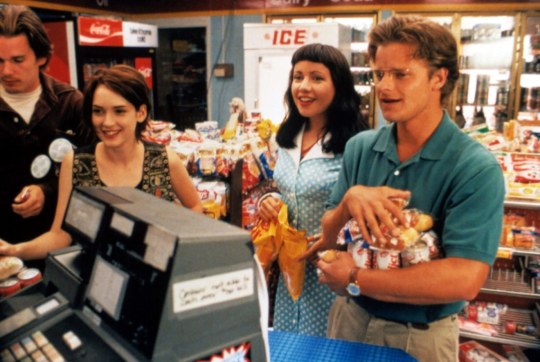
©Universal/Courtesy Everett Collection
In what was then a cult hit and is now a piece of ’90s nostalgia catnip, a post–Edward Scissorhands (and post–Johnny Depp) Winona Ryder plays Lelaina, an aspiring documentarian assisting an obnoxious TV host in Houston. She and grungy, Generation X friends—played by Steve Zahn, Janeane Garofolo, and a simmering Ethan Hawke (who may be more than just a friend)—are just trying to figure out who they are, and what they want in life. In Ben Stiller’s feature directorial debut, he also plays a TV executive whose budding romance with Lelaina and interest in her work brings the real world crashing into their postcollegiate hipster existence. Aside from a nonstop ’90s fashion buffet that is Winona’s wardrobe (mom jeans, crop tops, baby doll dresses, cardigans, men’s shirts, blazers), there’s also love and heartbreak, sex, betrayal, Lisa Loeb, Dickies, pizza, and lines like “He’s so cheesy, I can’t watch him without crackers.” What else do we want, really?
. . . to dance your troubles away:
Grease (1978)

©Paramount/Courtesy Everett Collection
The ’50s nostalgia of the 1970s culminated with this unreal musical about the return to high school for summer lovers Danny Zuko (John Travolta) and Sandy Olsson (Olivia Newton-John). It’s hard for current viewers to understand just how big John Travolta was at the time; the year this film bowed, 1978, the two top-selling albums were the soundtracks to Saturday Night Fever (another Travolta film) and this one. And that was in a year when the Rolling Stones released Some Girls and Bruce Springsteen dropped Darkness on the Edge of Town. In this irresistibly playful film, Travolta embodies the bursting sexuality of the newly emerged teen culture, but at the same time, he’s a tampered-down throwback—we buy him drag racing cars and singing with his gang, the T-Birds, whose rivals are the Scorpions, and making clumsy moves at the drive-in. Similarly, the Pink Ladies, a popular clique headed by Rizzo (Stockard Channing), deliver their wiseacre lines with a fair dose of irony. These skirts know what’s up, and that’s what makes us interested, and invested, in their outcomes. We’re locked in from the first frame: There may be better musicals, but none more fun.
. . . to get you through wedding season:
Four Weddings and a Funeral (1994)
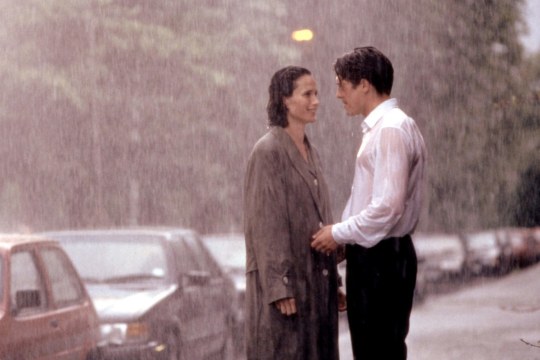
©GramercyPictures/Courtesy Everett Collection
For anyone who’s ever been encumbered by the beautiful, annoying, expensive ordeal that is a wedding, how can we not love a wedding movie whose first pages of dialogue are just the word Fuck? As much as we commiserate, this is ultimately Hugh Grant’s movie. And a little Andie MacDowell’s movie. But mostly Hugh Grant’s. It’s the film that introduced us to his stumbling, bumbling, yet confident Etonian charms and wit, which we’d witness again and again in Nine Months, Notting Hill, Music and Lyrics, About a Boy, and more). The story of Grant and his friends attending their friends’ weddings—and one funeral—perfectly captured the romance of nuptials as well as all the stress, commitment, and emotional . . . what do the British call it? . . . oh yes, bother that comes with that period in your life where your friends are tying the knot. The question this rom-com dares ask is this: In all this wedding madness, can you be the odd man out and still be happy?
. . . to find your prince:
Coming to America (1988)

©Paramount/Courtesy Everett Collection
It’s unfair that Eddie Murphy only has one entry on this list. The guy ruled the ’80s and made some of the era’s great comedies—Trading Places, Beverly Hills Cop, 48 Hrs.—but this is really the only one where the romance narrative rules supreme. In short: Murphy plays the prince of a fictional African nation who is unsure about his arranged marriage, and so heads to what he suspects will be greener pastures in search of his queen. So where better to start that Queens, New York? Essentially slumming it with his best friend (a terrific Arsenio Hall), Murphy’s character finds work at a McDonald’s-type restaurant where he falls in love with the owner’s daughter, a woman who just might fit the bill. It’s a super simple story that elicits big laughs in every scene, but it’s also a clever send-up of class and race that simultaneously owns itself as perhaps the ultimate Reaganite comedy: If you are rich and follow your heart, you can be even richer!
…remind you that life doesn’t always go as planned, but sometimes that’s okay.
Juno (2007)
Life’s not perfect, but it can be most endearing— that’s the takeaway, anyway, from Jason Reitman’s nuanced teen comedy, Juno. Ellen Page gives her breakout performance as the titular pregnant-by-accident teen who soldiers on through high school while preparing to give her baby up for adoption to a painfully needy rich couple (or “baby-starved wingnuts,” as her father calls them.) Juno’s honesty and her backward love story with the adorably nerdy Paulie (Micheal Cera) reminds us of the true meaning of being cool, and that heartache can resolve itself into a tender, resilient future.
. . . to get your boss’s job:
Working Girl (1988)

©20thCentFox/Courtesy Everett Collection
First, consider the cast: Melanie Griffith, Harrison Ford—who owned the ’80s in Hollywood and made this his only rom-com—Sigourney Weaver, Joan Cusack, Oliver Platt, Alec Baldwin (at his douchiest), and Kevin Spacey. Next, look at the director: Mike Nichols—if there is a pantheon for romantic films, he probably has Zeus’s seat. Finally, the shoulder pads; my god, the shoulder pads. Were doorways made wider in the 1980s? Adventures in Babysitting aside, this movie is really as feminist as mainstream movies got in the ’80s. Melanie Griffith plays Tess McGill, a wily business school graduate working as a secretary at an investment bank with such memorable one-liners as “I have a head for business and a bod for sin.” When her boss (Weaver) steals her idea for a merger and then ends up out of commission (temporarily bedridden after a ski accident), Tess rises to the occasion: scheming with the support of her friends and maybe-lover (Ford), conniving, flirting, and using some good old-fashioned elbow grease to outwit her superiors, beat the boys, and claim the position she’s rightfully earned. Griffith is miraculous (one critic compared her to Marilyn Monroe; younger viewers might see a mold for Alicia Silverstone’s Cher), taking a role that could have just been “cute” and elevating it to nuanced and beguiling. That’s what this film is—so much so, we’ll forgive you if, after watching it, you suddenly have a soft spot for shoulder pads.
(C)
2 notes
·
View notes
Text
Beanie Feldstein of Booksmart on Being “Built Happy,” Overcoming Tragedy and (of Course) Llamas
We’re on the patio at one of Beanie Feldstein’s favourite brunch spots. It feels transplanted from Los Angeles—which is to say there is a shocking dearth of deep-fried dishes. But the mechanical roar and shudder from a nearby construction crew, the buildings and the presence of Beanie* herself place us very clearly in New York. Chelsea, to be exact. And when in Chelsea with an impossibly charming actress well on her way to attaining her dream career, you talk about llamas.
* Author’s note: It’s journalistic convention to refer to a subject by his/her last name after his/her first appearance, but it feels wrong to do so with Beanie Feldstein. Beanie—a name her late brother gave her when she was a baby named Elizabeth—fits better. It’s like if Coca-Cola were a person, you wouldn’t call her Cola; it’s too broad and generic. No, you’d call her Coke.
“I loved llamas growing up,” says Beanie. “My second screen name ever, my second email, was pinkllamas12. My favourite colour, my favourite animal, my favourite number.”
As far as conversational tangents go, this isn’t that random. Beanie, whom you’ll recognize from playing the so-loyal-it-hurts best friend in Lady Bird along with the so-loyal-it’s-hilarious best friend in this past summer’s instant high school classic Booksmart, was talking about apartments in New York. This led to talk of dogs. Big dogs, specifically, and how, what with a roommate and all, she can’t get one at the moment. Helpfully, I asked if she had considered llamas. “They’re also quite tall.” Ha ha.
And so we spoke of llamas.
As it turns out, we each have one piece of llama trivia. Mine hasn’t exactly been fact-checked, so I’m concerned that my llama anecdote will contradict hers—and wouldn’t that be awkward? Rule number one of celebrity interviews: Don’t argue with the talent (especially about llamas).
Photography by Arkan Zakharov. Styling by Anna Katsanis. Creative direction by Brittany Eccles. Hair, Peter Butler for TraceyMattingly.com. Makeup, Matin for TraceyMattingly.com/Nars. Manicure, Miss Pop/Zoya Nail Polish. Fashion assistant, Paulina Castro Ogando. Photography assistants, Ian Bishop and Alicia Brooks.
“From what I read when I was 11, you have to have at least two llamas,” she says. “Because if a llama doesn’t get attached to another llama, it’s going to get attached to you and then be violent with anyone who comes near you. But if you have two, they’ll get attached to each other.”
My tidbit is that instead of using sheepdogs (or maybe in addition to using sheepdogs…my knowledge of shepherding practices comes almost exclusively from Looney Tunes), shepherds will sometimes put a llama in with their flock. So long as that llama remains singular, it will defend its little woolly cousins against all comers—will literally flatten any coyotes that come sniffing around. But if that llama has a llama friend, it could give a shit about those damn sheep.
The point of both of our anecdotes is the same: Llamas have very powerful feelings. And as such, they provide an imperfect yet apt metaphor for who Beanie is (minus what are clear co-dependency issues on the part of the llama).
Photography by Arkan Zakharov. Styling by Anna Katsanis. Creative direction by Brittany Eccles. Hair, Peter Butler for TraceyMattingly.com. Makeup, Matin for TraceyMattingly.com/Nars. Manicure, Miss Pop/Zoya Nail Polish. Fashion assistant, Paulina Castro Ogando. Photography assistants, Ian Bishop and Alicia Brooks.
“I love deep,” Beanie tells me later. It might be the truest statement anyone has ever made. In the hour we talk, Beanie uses the word “love” approximately 60 times. If she mentions someone—a director or past co-star or anyone—she’ll first list specific reasons why she loves them. And hers isn’t the “Oh, Marty Was Such a Thrill to Work With” kind of talk show praise that celebrities usually dish either. It sounds genuine—like everyone is a friend she met at camp and can’t wait to tell you about.
“It’s very rare for me not to connect with people,” she says. “It’s subconscious: I feel connected or I don’t. Every now and then, I’m wrong. And it hurts. But I think I just sort of know. I just love deeply.”
Photography by Arkan Zakharov. Styling by Anna Katsanis. Creative direction by Brittany Eccles. Hair, Peter Butler for TraceyMattingly.com. Makeup, Matin for TraceyMattingly.com/Nars. Manicure, Miss Pop/Zoya Nail Polish. Fashion assistant, Paulina Castro Ogando. Photography assistants, Ian Bishop and Alicia Brooks.
She just knows herself, too. And I get the sense that, more importantly, she likes herself. That’s a big part of why she can be so positive about pretty much everything. That might sound like she’s a typical millennial, pumped full of untested self-esteem. But it’s not like that. It’s a choice, and it’s one that doesn’t go unchallenged. After all, one assumes that being a plus-size actress in Hollywood comes with certain pressures that can be anathema to self-acceptance.
In a brief essay for Refinery29, she wrote about how precarious and hard-fought self-love can be, at least when it comes to her body. After unintentionally losing weight after a stint on Broadway, she noticed how many comments and compliments she was getting about her looks. “It really messed with my head,” she wrote. “After years of pain, I had finally found such a beautiful peace, one that most people, no matter what size they are, don’t have […]. But here’s the issue: When everyone started telling me I looked smaller, I lost my beautiful mindset that took decades to find.” Her self-acceptance and confidence don’t come from outside; they come from her own self-awareness. She has a healthy understanding of her talents as well as her weaknesses.
“When everyone started telling me I looked smaller, I lost my beautiful mindset that took decades to find.”
Her upcoming film, How to Build a Girl, is based on the novel by Caitlin Moran (“so charismatic and so effervescent and magical”). Beanie plays a girl named Johanna, who is “so different from Caitlin.” The character and Moran do, however, share a pretty similar biography. They are both music critics from the British town of Wolverhampton and speak like it. It’s not an accent that comes naturally to anyone not from Wolverhampton; it’s an accent that even her girlfriend, English film producer Bonnie-Chance Roberts, couldn’t help her with. “It’s not just a British accent,” she says. “Coky [Giedroyc, the director] was like, ‘Even as Londoners, we don’t know how to do that accent.’”
Photography by Arkan Zakharov. Styling by Anna Katsanis. Creative direction by Brittany Eccles. Hair, Peter Butler for TraceyMattingly.com. Makeup, Matin for TraceyMattingly.com/Nars. Manicure, Miss Pop/Zoya Nail Polish. Fashion assistant, Paulina Castro Ogando. Photography assistants, Ian Bishop and Alicia Brooks.
“I’m not an accent savant like some people,” says Beanie. “Saoirse Ronan is brilliant in every way, but her work with accents is so insane. I approached it academically.” She’ll tell you, without self-deprecation or false modesty, that she is neither the most creative nor the most intelligent in her family. But she is the most academic.
“I know the moment I got the part,” she says. “I was Skyping with the producers before I went to London for my audition. And they were like, ‘We looked all around for someone from Wolverhampton to play Johanna.’ But they couldn’t find anyone and so they were looking all over the U.K. I was like, ‘If you’re not casting someone from Wolverhampton, then anyone would be doing an accent.’ And I saw their heads cock, and it was the right thing to say.”
Bold, right? But then she had to work to nail Moran’s accent—which took a three-week immersion in Wolverhampton-ese while embedded in one of the town’s female-run shops. She said it was awkward at first, since she was under orders to speak in the accent well before she had it down, but what’s a little discomfort if it means getting to work with someone like Moran?
Photography by Arkan Zakharov. Styling by Anna Katsanis. Creative direction by Brittany Eccles. Hair, Peter Butler for TraceyMattingly.com. Makeup, Matin for TraceyMattingly.com/Nars. Manicure, Miss Pop/Zoya Nail Polish. Fashion assistant, Paulina Castro Ogando. Photography assistants, Ian Bishop and Alicia Brooks.
“She is everything I would want to be as a woman,” she says. “I just couldn’t believe that they chose a Jewish girl from Los Angeles. And I think in my core they saw something in me that Johanna has, which is like an eternal optimism.”
And like with her character, it’s an optimism that has been tested. As a good sociology grad (Weslyan ’15), she knows that her life has been privileged: raised in Los Angeles by well-off, creative parents; a famous older brother (named Jonah Hill); loads of natural talent and charisma. But that doesn’t mean she hasn’t had challenges or faced grief.
Her oldest brother, Jordan, was a manager for Maroon 5, Robin Thicke and Elle King. He died at the end of 2017 from a blood clot in his lung. “It’s unbearable at times,” she says. “But it doesn’t linger in me. I mean, my tragedy lingers in me every day. My grief is something that I am alongside every single day. But it doesn’t present itself as depression or sadness.”
“It’s unbearable at times. But it doesn’t linger in me. I mean, my tragedy lingers in me every day. My grief is something that I am alongside every single day.”
There’s a difference between eternally optimistic and blindly optimistic. She knows that life is hard and things are shitty. And it’s hard to keep a big heart from getting hurt every now and then, but all the pain isn’t pointless. “I found myself unwillingly in a new club,” she wrote in an essay for InStyle. “It is a club full of suffering and questioning but is also a community of people who have a truly broadened perspective on the human experience.”
And while it doesn’t make up for the loss, that kind of perspective is helpful when your job is to inhabit different human experiences. “I think one of the most beautiful lines I got to say in Lady Bird was ‘Some people just aren’t built happy,’” she says. “I was really struck, because I have no words for how much I miss my brother, but I think that I am just built happy.”
Photography by Arkan Zakharov. Styling by Anna Katsanis. Creative direction by Brittany Eccles. Hair, Peter Butler for TraceyMattingly.com. Makeup, Matin for TraceyMattingly.com/Nars. Manicure, Miss Pop/Zoya Nail Polish. Fashion assistant, Paulina Castro Ogando. Photography assistants, Ian Bishop and Alicia Brooks.
After reading all this, you shouldn’t be surprised that Beanie is a theatre person. She fell in love with Funny Girl before she was old enough for kindergarten. She spent most of 2017 on Broadway starring in Hello, Dolly! with Bette Midler. (Bet you can’t guess how Beanie feels about her.) Theatre—musical theatre, specifically—might be the only thing she loves more than…all of the other things she loves.
“I think one of the most beautiful lines I got to say in Lady Bird was ‘Some people just aren’t built happy.’ I was really struck, because I have no words for how much I miss my brother, but I think that I am just built happy.”
Considering how many theatre nerds there are around the world, there are relatively few true theatre people in Hollywood, but you know them when you see them: enthusiastic, touchingly game, often improbably good at accents (spoiler alert: Beanie can talk like a native of Wolverhampton now) and probably on the verge of tears (happy or sad) at this very moment. “They are people with the biggest hearts,” she explains. “I’ve never met a more hard-working people than the theatre community. Broadway is a slow burn of commitment.”
Maybe the size of their hearts helps with the required energy as well as her craft. She’s not a method actor. She connects to her characters through empathy, through inherent understanding and love.
Photography by Arkan Zakharov. Styling by Anna Katsanis. Creative direction by Brittany Eccles. Hair, Peter Butler for TraceyMattingly.com. Makeup, Matin for TraceyMattingly.com/Nars. Manicure, Miss Pop/Zoya Nail Polish. Fashion assistant, Paulina Castro Ogando. Photography assistants, Ian Bishop and Alicia Brooks.
One final observation: Beanie’s first breakout role was in Neighbors 2. She played a freshman student who started a wildcat sorority with Chloë Grace Moretz. In her next two major roles, she was a senior in high school. “And, now, in How to Build a Girl I’m 16,” she says. “I’m Benjamin Buttoning, which is funny because I’ve always felt like an old soul.”
Beanie passes as a teenager, of course, especially since we’re used to seeing 25-year-old high-schoolers in pop culture. But I think she keeps getting younger and younger in her roles as a corrective. Even though she’s only in her early twenties, we regret that we didn’t find her sooner, that we weren’t friends with her in high school. So, we’re going to force her back there. We want her in our musicals, films and lives for as long as possible.
Actually, maybe we’re the llamas in this metaphor.
Photography by Arkan Zakharov. Styling by Anna Katsanis. Creative direction by Brittany Eccles. Hair, Peter Butler for TraceyMattingly.com. Makeup, Matin for TraceyMattingly.com/Nars. Manicure, Miss Pop/Zoya Nail Polish. Fashion assistant, Paulina Castro Ogando. Photography assistants, Ian Bishop and Alicia Brooks.
Photography by Arkan Zakharov. Styling by Anna Katsanis. Creative direction by Brittany Eccles. Hair, Peter Butler for TraceyMattingly.com. Makeup, Matin for TraceyMattingly.com/Nars. Manicure, Miss Pop/Zoya Nail Polish. Fashion assistant, Paulina Castro Ogando. Photography assistants, Ian Bishop and Alicia Brooks.
Photography by Arkan Zakharov.
Photography by Arkan Zakharov. Styling by Anna Katsanis. Creative direction by Brittany Eccles. Hair, Peter Butler for TraceyMattingly.com. Makeup, Matin for TraceyMattingly.com/Nars. Manicure, Miss Pop/Zoya Nail Polish. Fashion assistant, Paulina Castro Ogando. Photography assistants, Ian Bishop and Alicia Brooks.
Photography by Arkan Zakharov.
Photography by Arkan Zakharov. Styling by Anna Katsanis. Creative direction by Brittany Eccles. Hair, Peter Butler for TraceyMattingly.com. Makeup, Matin for TraceyMattingly.com/Nars. Manicure, Miss Pop/Zoya Nail Polish. Fashion assistant, Paulina Castro Ogando. Photography assistants, Ian Bishop and Alicia Brooks.
Photography by Arkan Zakharov. Styling by Anna Katsanis. Creative direction by Brittany Eccles. Hair, Peter Butler for TraceyMattingly.com. Makeup, Matin for TraceyMattingly.com/Nars. Manicure, Miss Pop/Zoya Nail Polish. Fashion assistant, Paulina Castro Ogando. Photography assistants, Ian Bishop and Alicia Brooks.
Photography by Arkan Zakharov. Styling by Anna Katsanis. Creative direction by Brittany Eccles. Hair, Peter Butler for TraceyMattingly.com. Makeup, Matin for TraceyMattingly.com/Nars. Manicure, Miss Pop/Zoya Nail Polish. Fashion assistant, Paulina Castro Ogando. Photography assistants, Ian Bishop and Alicia Brooks.
Photography by Arkan Zakharov. Styling by Anna Katsanis. Creative direction by Brittany Eccles. Hair, Peter Butler for TraceyMattingly.com. Makeup, Matin for TraceyMattingly.com/Nars. Manicure, Miss Pop/Zoya Nail Polish. Fashion assistant, Paulina Castro Ogando. Photography assistants, Ian Bishop and Alicia Brooks.
Photography by Arkan Zakharov. Styling by Anna Katsanis. Creative direction by Brittany Eccles. Hair, Peter Butler for TraceyMattingly.com. Makeup, Matin for TraceyMattingly.com/Nars. Manicure, Miss Pop/Zoya Nail Polish. Fashion assistant, Paulina Castro Ogando. Photography assistants, Ian Bishop and Alicia Brooks.
1/10
Beanie Feldstein
Dress, price upon request, Jonathan Simkhai at Rent the Runway. Earrings, $200, Jennifer Fisher. Rings (worn throughout), Beanie’s own.
2/10
Beanie Feldstein
Dress, $3,170, and shoes, $1,255, Marc Jacobs.
3/10
Beanie Feldstein
4/10
Beanie Feldstein
Dress, $2,860, Erdem at The Room. Shoes, $775, Stuart Weitzman.
5/10
Beanie Feldstein
6/10
Beanie Feldstein
Dress, $3,070, Balenciaga at Saks Fifth Avenue. Shoes, $1,875, Jimmy Choo. Belt, stylist’s own.
7/10
Beanie Feldstein
Top, $750, Versace at Holt Renfrew. Bracelet, Beanie’s own.
8/10
Beanie Feldstein
Top, $750, Versace at Holt Renfrew. Bracelet, Beanie’s own.
9/10
Beanie Feldstein
Dress, price upon request, Jonathan Simkhai at Rent the Runway. Earrings, $200, Jennifer Fisher. Shoes, $1,250, Gucci.
10/10
Beanie Feldstein
Dress, $170, Rahi at Shopbop. Shoes, price upon request, Salvatore Ferragamo.
The post Beanie Feldstein of <em>Booksmart</em> on Being “Built Happy,” Overcoming Tragedy and (of Course) Llamas appeared first on FASHION Magazine.
Beanie Feldstein of Booksmart on Being “Built Happy,” Overcoming Tragedy and (of Course) Llamas published first on https://borboletabags.tumblr.com/
0 notes
Text
Does the PlayStation Classic’s Lineup Live Up to the Original System’s Legacy?
The console race of the 1990s has reared its head again in recent years. However, this time it’s presented in a miniaturized format. What started off with the now iconic NES Classic from Nintendo soon gave life to a whole range of tiny machines imitating the heavy hitters of days gone by.
Since then, we’ve seen Nintendo jump back into the fray with a rendition of the SNES, SEGA kicking things into high gear with its upcoming tiny Genesis, and even the ’80s-era Commodore 64 getting a bite-sized new lease on life. Of course, with the wheels officially in motion, it was only a matter of time before Sony Interactive Entertainment dipped its toe in the water to bring new life to its oldest gaming conquest: the PlayStation.
“The PlayStation didn’t just feel like a console, it felt like a movement; a gargantuan push forward towards a more advanced gaming world.”
The PlayStation Classic is tasked with carrying the weight of a generation-defining machine on its tiny shoulders. When the original PlayStation launched more than two decades ago, it changed the way we play video games forever. It bravely made the leap from 16-bit gaming to fully fleshed-out 3D experiences, a generational leap the likes of which we’d never seen. It gave birth to a number of titles and characters who have since become household names, and it did it all with a hyperactive edgy overtone that would appeal to players in their teens.
Put quite simply, the original PlayStation was ground-breaking. Its shockwave was felt throughout the gaming world and its effects have spilled over to the subsequent generations of consoles that followed. The PlayStation didn’t just feel like a console, it felt like a movement; a gargantuan push forward towards a more advanced gaming world. The edgy titles and attitude that coincided with it were rebellious in nature, and it genuinely felt like gaming was growing up from its childhood years to embrace a more mature outlook on life.
Is it possible to instill that feeling, that effect, and that attitude into a device that can fit into the palm of your hand, or is the PlayStation Classic doomed to fail? In order to decipher this, we’ve got to take a look back at what the PlayStation really brought to the table, and what games are included in its cute little modern outing.
The PlayStation’s “I-don’t-care” attitude didn’t just come from its completely over-the-top advertising campaigns which embraced the true nature of just how wild the 90s could be. No, instead it was the games that really propelled the machine. Looking back now, more than two decades after the system first exploded onto the screens of our old CRT TVs, there are a number of titles that instantly come to mind because they changed the face of gaming forever.
First and foremost there was the machine’s unofficial mascot, Crash Bandicoot. Crash, like any characters that could be referred to as a mascot at the time, starred in platforming games. Proudly sporting its cartoonish 3D graphics, this anthropomorphic little animal sprinted through busy levels while spinning his foes into oblivion. The fast-paced, reckless nature of the game made it an instant hit and the system followed up with two direct sequels, each of which improved upon the original’s rocky beginnings, and a number of off-shoot titles which saw the cast of the Crash’s universe engaging in go-karting (which is getting its own remaster very soon) and other silly party games.
“The unfortunate truth is that a good chunk of games that would be seen as PlayStation heavy hitters are similarly tied up in this day and age.”
Something about Crash Bandicoot stuck a chord with players and, although he has appeared on Microsoft and Nintendo consoles since, he’s seen as being synonymous with the original PlayStation. Unfortunately though, possibly due to the recently-released Crash Bandicoot: N. Sane Trilogy, the crazed jeans sporting animal didn’t end up making a triumphant return on the PlayStation Classic.
The unfortunate truth is that a good chunk of games that would be seen as PlayStation heavy hitters are similarly tied up in this day and age. The 1990s’ adorable little dragon, Spyro, for example, has also recently starred in a gorgeously remastered rendition of his original adventures. Old Sir Daniel Fortesque of MediEvil fame will also be seeing a PlayStation 4 remaster in the near future, so that pretty much crosses the concept of his title making an appearance off the list too. The same could be said for fan-favorite Castlevania: Symphony of the Night which was recently included in a downloadable bundle.
Next up is the now iconic Lara Croft. The first Tomb Raider title has aged surprisingly well throughout the years. Overshadowed in many ways by Tomb Raider II, 1996’s original introduced us to a character who dominated the gaming scene for the remainder of the century. Perfectly timed and riding the wave of the Spice Girls’ movement of “girl power,” Lara Croft was a no-nonsense action hero whose ferocious combat skills and agility were surpassed only by her boundless intellect.
Lara Croft quickly became another iconic face of PlayStation, and indeed the face of gaming during that era. She appeared in soft drink advertisements, toured with U2, and made the cover of then-popular magazine The Face, and this was all before Angelina Jolie portrayed her in 2001’s major motion picture adaptation of the franchise (and the accompanying 2018 film starring Alicia Vikander). Bizarrely though, she too seems to be absent from the PlayStation Classic’s lineup, likely because of the recent reboot titles from Square Enix.
“It would be unfair to say that there aren’t any fantastic games pre-installed in the cute little machine.”
The list of classic characters and games that haven’t made the cut for the PlayStation Classic seems to go on and on. Early PlayStation titles such as Loaded would have fit right at home on the bite-sized device, as would the likes of Die Hard Trilogy. Iconic characters such as PaRappa the Rapper and memorable games Pandemonium! didn’t make an appearance either, and neither did any of the entries in PlayStation’s signature futuristic racing franchise, Wipeout.
With all of these games lacking, what exactly does that leave for the PlayStation Classic when it comes to representing the era it came from? It would be unfair to say that there aren’t any fantastic games pre-installed in the cute little machine. Final Fantasy VII, for example, leads the charge and is regarded by many to be one of the greatest games ever created. Tekken 3 is by far the best 3D fighter that the original console had to offer, and it still plays fantastically today. Grand Theft Auto is a fun little title that now serves as an interesting history lesson for fans of the series and Rockstar Games, proving that great things are possible from incredibly humble beginnings. This top-down 2D title laid the groundwork for what was to become one of the most successful franchises of all times. Then there’s the bizarre but charming Oddworld: Abe’s Oddysee that certainly deserves a slot, as does the original Destruction Derby for nostalgia’s sake.
To top it off, there’s no denying the sheer power and influence that the original Metal Gear Solid had over gaming as a whole. It integrated cinematic story-telling into video games in a way that we’d never seen before and single-handedly revolutionized the very concept of narratives within games. Again, this is a front-runner on the PlayStation Classic, and rightly so. It has earned its place as one of the system’s greatest and most well-loved titles.
Following these stellar games, though, are some seemingly bizarre choices that tend to miss the mark again and again. Mr. Driller and Super Puzzle Fighter II: Turbo both seem entirely out of place here, almost like last minute choices that simply didn’t pay off: Intelligent Cube also falls under this category. Cool Boarders 2 is a nice addition, but could and should have been swapped out for Tony Hawk: Pro Skater 2, which is superior and infinitely more popular in every way.
“The PlayStation Classic sadly seems like it will go down in history as a misfire.”
None of these titles are bad. They are all decent in their own rights, but they are by no means classic, especially not when compared to heavy hitters such as Tomb Raider, Silent Hill, Medal of Honor, Legacy of Kain: Soul Reaver, Rollcage, Tenchu: Stealth Assassins, Driver, or Dino Crisis. Even choices such as Twisted Metal seem a little unusual considering how badly this particular game has aged. It seems stranger still when you consider that its vastly superior sequel Twisted Metal 2: World Tour still plays brilliantly in 2018.
There is a sea of phenomenal games spread across the original PlayStation’s thick and robust catalog, but it simply seems like all we’ve got here is wave after wave of wasted potential and missed opportunities. What should have been a sure-fire line-up of stellar genre-defining titles wound up being a mishmash of games that might make you think that there was a misunderstanding about the definition of the word “classic.”
The PlayStation Classic sadly seems like it will go down in history as a misfire; a half-cocked attempt to follow in the footsteps of Nintendo’s miniature consoles but without truly knowing what made Sony’s original voyage into the world of gaming magical. Perhaps there are lessons to be learned here, and we’ll see a revised release at some stage in the future. For now, though, the PlayStation Classic seems destined to sit in the shadows of Nintendo’s outings to think about where it went wrong until it eventually drifts into obscurity.
The post Does the PlayStation Classic’s Lineup Live Up to the Original System’s Legacy? by Eoghan Murphy appeared first on DualShockers.
Does the PlayStation Classic’s Lineup Live Up to the Original System’s Legacy? published first on https://timloewe.tumblr.com/
0 notes
Text
Best Amazon Prime TV shows US
http://www.internetunleashed.co.uk/?p=18878 Best Amazon Prime TV shows US - http://www.internetunleashed.co.uk/?p=18878 Ah summer. At one time the warmer months meant nights spent beneath the warm glow of the drive-in movie projector. These days ... not so much.Thankfully, Amazon Prime Video is here to pick up the slack.While the service catches a lot of flak for uninteresting, non-noteworthy shows, there's actually a treasure trove of content waiting to be discovered ... if you know where to look.That’s why we're here to help you make that all important decision about which TV series you should binge watch this weekend and what we recommend you should skip. We've collected together a big selection of TV shows for you to choose from, including shiny new series through to Amazon's own original shows. In our guide you'll discover our pick of the best Amazon Prime TV shows that are currently on offer. We have options for fans of thrillers, comedy lovers and those who enjoy nothing more than a fantasy police drama. So, what's the best Amazon TV show to get sucked into without regretting it by the end of season 2? Read our Prime Video recommendations to find out.[Update: Looking for some classic Aughts TV? Suits is now available on Amazon Prime Video as is the much darker, much newer fifth season of Orphan Black.] You'll need a Prime subscription to watch Amazon Prime Instant Video for free, and best of all, you can get a free 7-day trial of Amazon Prime Video Amazon has been developing and creating titles itself over the past few years, which are called Amazon Originals or Amazon Original Series.These homegrown TV shows are arguably some of the best that the Amazon Prime Video service has to offer (think The Tick and Transparent), which you can watch instantly when you have Amazon Prime access. There are many more shows you can watch through Amazon too of course, but some of these have to be purchased in order for you to start streaming. We'll be keeping this list constantly updated – if any paid shows become free that we feel need to be included, they'll be added too. Scroll through to see our picks that we've divided up into the following categories: drama, comedy and thriller. If you can only watch one... The Marvelous Mrs. Maisel Nominated for the Emmy in Outstanding Comedy Series, The Marvelous Mrs. Maisel tracks Midge on her rise to the top of the comedy scene in the 1950s. The basic premise of the show is that Midge, a perfect stay-at-home wife, never quite gets the recognition she deserves from her drunk, deadbeat comedian husband. She picks up the mic herself and, as it turns out, is actually funnier than her lesser half. The monologues Midge delivers feel as appropriate for today's audiences as they were for the fictional crowd in the '50s, if not moreso. The result is genuinely funny, inspirational and, above all, human. Check out our in-depth Amazon Prime Video reviewFancy a film? Then our best Amazon Prime movies feature is for youWant to see what the rival is doing? Then check out best Netflix TV showsThese are the best movies on Netflix Amazon Prime or Netflix? Check out our comparison video below! Absentia If you've had a Stana Katic shaped hole in your life since Castle ended in 2016, you'll be glad to know she's starring in a brand new series on Amazon Prime. Katic takes up the role of FBI agent Emily Byrne who, six years after being declared dead, returns to the world and has to try and piece her life and memory back together. Seasons on Amazon Prime Video: 1 Animal KingdomLooking for a new crime drama to get stuck into? Animal Kingdom could be what you're looking for. The show follows teenager J Cody who moves in with extended relatives in Southern California after the death of his mother. Far from being boring, Cody finds his relatives live a wild life of excess and it's all funded by crime.Seasons on Amazon Prime: 2 BoschWith 20-something novels to mine for source material, Bosch is a character that was always destined for the small screen. Created by Michael Connelly but brilliantly brought to life by actor Titus Welliver, the series follows the exploits of LA Homicide detective Harry Bosch and features enough grit to pave the longest of driveways.This is no surprise - the series has been created by Eric Overmyer, who was part of the alumni that created The Wire. Bosch is another show that has been put together by Amazon Studios - proving that streaming services are becoming just as powerful as the HBOs of the world when it comes to producing compelling drama.Bosch Season 4 has now landed on Amazon Prime, continuing the saga of Harry Bosch and it comes with a nice uplift in quality too, building season upon season to become one of our favourite shows on Prime at the moment. Number of seasons on Amazon Prime: 4 GoliathBilly Bob Thornton stars as a washed-up lawyer looking for a big break who stumbles on to a big case that may well give him the solace he needs. Made by David E Kelly who loves a bit of courtroom drama, having already created Boston Legal, The Practice and Ally McBeal, the show works well as a standalone series but there's talk that it may get a second season. Goliath is part of Amazon's Original series of TV shows.Seasons on Amazon Prime: 1 Good Girls RevoltLet me set the stage for this one: It's 1969, and there's a war going on in America. The war is being fought in business offices around the country and the group leading the charge are women in the workforce, fighting for equal rights and equal acknowledgement for the work they've performed for years. Good Girls Revolt is set in this backdrop, at a fictional news outlet where the women have for too long been swept under the rug.The show scores major points for its poignant subject matter – both in the way that it covers the struggles of women in the workplace pre-1970, but also in the way it handles talking about the American history that the women in question are tasked with covering. Part raunchy history lesson, part stellar drama, Good Girls Revolt is a smart interpretation of a still-ongoing issue.Seasons on Amazon Prime Instant Video: 1 Hand of GodLast seen in Sons of Anarchy, Ron Perlman has moved from the mad world of biker gangs into the stranger world of law. Perlman plays a vice-riddled barrister who, after suffering a breakdown, starts to believe he is a messenger from god.The full first season for Hand of God arrived on Amazon Prime, after a successful pilot. A second season is also available, which will sadly be the last as Amazon has decided to not renew the show. This is a shame as it may not be a light-hearted ride - but it is one drama that takes dark turn after dark turn and is all the better for it.Seasons on Amazon Prime: 2 The Last TycoonF Scott Fitzgerald may be known for The Great Gatsby and Tender Is The Night but The Last Tycoon - his last and unfinished novel - is perhaps his most ambitious piece of work. It peels away the glitz and glamour of Hollywood in the '30s to show a time when backstabbing was the norm, fascism was on the rise and everyone had an unbelievable amount of money. Kelsey Grammer is superb as movie mogul Pat Brady, while Matt Bomer is also great as Monroe Stahr, the up and coming film exec who wants to make it big. The Last Tycoon is occasionally flawed but it's a sumptuous watch.Seasons on Amazon Prime: 1 Downton AbbeyLike watching fictional posh people live their lives in early-twentieth century opulence? You're not alone – millions of people tuned in to Downton Abbey during its TV run, and it's now available to stream in its entirety on Amazon Prime Video.Following the trials and tribulations of the Crawley family on the titular Downton Abbey estate, it's a kitchen sink drama of sorts – except all the cutlery is made of silver, and it's an army of servants doing the washing up. Seasons on Amazon Prime Video: 7 Sneaky PeteSneaky Pete's plot maybe a little cliche - a con man assumes the identity of someone else to try and make a new break in the world - but Giovanni Ribisi is superb as Marius, the titular character and there's plenty of intrigue to keep you glued to this new Amazon Original. Interestingly, the show is co-created by Bryan Cranston which makes him the streaming king, given he's done so well with Breaking Bad on Netflix. Don't expect Sneaky Pete to be as intense as Breaking Bad - it's a crime caper, yes, but it doesn't take itself too seriously. As of March 2018, the second season of Sneaky Pete has landed on Amazon. The premise is that Marius is on the cusp of starting fresh and leaving all of his mess behind. But that'd hardly make a compelling second season, would it? Luckily for fans he's dragged back into the drama kicking and screaming.Seasons on Amazon Prime: 2 TransparentAnything Netflix can do, Amazon Prime can do better it seems, especially when it comes to winning a Golden Globe. Netflix may have made history by being the first streaming service to win a Golden Globe, courtesy of the acting talents of Kevin Spacey in House of Cards, but Amazon went and topped this by winning the Best TV Show prize in 2014 for Transparent.It was much deserved. Transparent is everything you want in a TV show. It's heartwarming, funny and packs a real punch about a subject that doesn't get enough attention: transgenderism. Jeffrey Tambor's Maura Pfefferman is a television character we hope will be around for a long time.The fourth season will be available to stream from 22 September.Seasons on Amazon Prime: 3 Comedy Alpha HouseOne of the first successes to come from the Amazon Originals program, Alpha House is the antithesis of Netflix's House of Cards. Yes it has a political edge but the back stabbing is replaced with a little bit of rib tickling. John Goodman is superb as one of four US senators shacked up in the same house.While the humor may get a little too dry for some, there's warmth in the cynicism and a strange amount of believability in the characters. If you were to choose one comedy that lampoons US politics then go with Veep - but Alpha House is a decent second.Seasons on Amazon Prime Instant Video: 2 Jean-Claude Van JohnsonOkay, we'll admit this show isn't quite as good as its teaser promised us. But it is still a fun, meta look at the man, the myth Jean-Claude Van Damme who plays, well, Jean-Claude Van Damme. It's only six episodes long but it's a lot of fun, showing Jean as a black-ops spy who has been covering as an actor all along. Yeah, right. This means that he's still an ass-kicking action hero but a real life one. Well, an actor playing an actor playing a black-ops operative who pretends to be an actor. If that sounds like your thing, then Jean-Claude Van Johnson is for you. Seasons on Amazon Prime: 1 CatastropheFrom the minds of Sharon Horgan and Rob Delaney comes one of the funniest, most well-written sitcom in years. The plot is slight: a one-night stand turns into a relationship once Sharon announces she is pregnant. But the series contains some of the most cut-to-the-bone humour seen on TV. Combine this with a nice slab of pathos - nestled among many a sex joke - and what you have is a modern classic.The third series, which recently aired on Channel 4, is now available on Amazon Prime Video - it features the last ever performance from the imitable Carrie Fisher.Seasons on Amazon Prime: 3 Comrade DetectiveComrade Detective is a weird gem on Amazon. Starring Channing Tatum and Joseph Gordon-Levitt, the show is a parody of gritty American buddy cop shows and Communist Propaganda from the Cold War.It's an unusual combination, but it works. Each episode is presented as though it's a remastered real episode of a lost Romanian Communist Propaganda series from the 80s which was used to entertain and promote Communist ideals. The entire show was filmed in Romania with Romanian actors and then dubbed over by Tatum and Gordon-Levitt.Seasons on Amazon Prime: 1 The TickWe like a dark twist on the superhero genre as much as the next person, and The Tick delivers it: it's about an accountant with mental health issues, who may or may not be a superhero - it could all be in his head. Peter Serafinowicz is the eponymous Tick, and despite that rather sombre-sounding plot outline, this is a black and surreal comedy worth seeking out.The first half of the first season of The Tick has been on Amazon Prime since 2017, but as of March 2018 the second half is here and it manages to be even more baffling, entertaining and laugh-out-loud funny than the first.Seasons on Amazon Prime: 1 The Grand TourClarkson, Hammond and the other one are back for Grand Tour: Season 2. Well, we kind of knew that they would be as they all have massive contracts that mean we will be seeing quite a few seasons of the Definitely Not Top Gear But Quite A Bit Like Top Gear show. This season sees Clarkson drive a fast car, Hammond drive a faster car and nearly die, and the other one drive a fast car considerably slower than the rest. If you enjoy watching middle aged men burn rubber in the middle of the desert, like a scene out of Mad Max: Fury Road, then this is for you. And if we haven't quite convinced you yet - Gizmodo offered up this quote about the show: "Some men doing stuff for no clearly defined reason." Lovely stuff. Seasons on Amazon Prime: 2 (new episodes weekly) I Love DickRecently graduating from Amazon Originals pilot to fully fledged TV show, I Love Dick is a great subversive watch. The show stars Kevin Bacon and is based on the celebrated book that looks at a married couple who are having marriage issues and their relationship with college professor, Dick. Bacon is on top form as the charismatic Dick and the show's multiple POV storytelling (Rashomon style) works well.Seasons on Amazon Prime Video TV: 1 The Marvelous Mrs. MaiselA new series from Gilmore Girls creator, Amy Sherman-Palladino, The Marvelous Mrs Maisel tells the story of 1950s Jewish housewife Miriam Maisel. After her husband confesses he's been having an affair, Midge drunkenly gets on stage at a comedy club and discovers that she's utterly hilarious. In a time when women aren't encouraged to be publicly funny, Midge pursues her new-found comedic talent in the male-dominated stand up comedy world. Season one is on Amazon now, but a second has already been ordered.Seasons to watch on Amazon Prime: 1 Mad DogsThe UK version of Mad Dogs was a breath of fresh air when it first aired. Well, the first season was then it all went a little too strange. This remake - green-lit from Amazon's burgeoning Originals series - takes the best from the UK version and mixes it with a plot that's a little easier to follow and humour that's more laugh out loud than pitch black.The premise is the same: a bunch of mates go and visit one friend at his luxury villa to celebrate his early retirement, only for murder, mayhem and mind-boggling plot developments to ensue. A touch of genius is the recasting of Ben Chaplin. While he played the rich, retiring Alvo in the UK version here he gets to try his luck in a bigger and better role.Seasons on Amazon Prime: 1 Mozart in the JungleNow into its fourth series, Mozart in the Jungle was this surprise winner at the 2015 Golden Globes, where it won Best Comedy Series. The show is a comedy set in the strange world of classical music. Gael García Bernal plays young conductor Rodrigo who replaces a retiring conductor played by Malcolm McDowell. Based loosely on a true story and created by the likes of Jason Schwartzman and Roman Coppola, it's well worth a watch.Seasons on Amazon Prime Video: 4 Parks and RecreationParks and Rec is a joy of a show. Originally seen as a quasi spin-off of the Office - using the same documentary style camerawork, awkward pauses, asides to camera - it soon grew from an amusing first season, about the goings on in the parks department of Pawnee, to a comedy phenomenon that spanned a fantastic seven seasons. It's not just the script that makes it great, it's also the characters - headed up by the ever-brilliant Amy Poehler.Seasons on Amazon Prime: 7 Red OaksThe '80s is the en vogue decade when it comes to nostalgia. Not only are Seth Gordon and Adam Goldberg mining the era for their superb prime-time sitcom The Goldbergs, Red Oaks has appeared to prove that it is respectable to set shows in the '80s. Amazon-exclusive Red Oaks - made by another Green, this time David Gordon - focuses on David, a tennis player at the Red Oaks country club and his summer shenanigans. Great casting - Jennifer Grey! - some brilliant nods to '80s films, a short run time means this is a series you can eat up in one neon-fuelled sitting.The third and final season is now available to stream in its entirety on Amazon Prime and is a fitting end to one of the best shows around at the moment. Seasons on Amazon Prime Video: 3 Thrillers NEW SEASON: The AmericansThe Americans was cruelly mishandled when it originally came to UK TV, so we are glad it has finally found a decent place to reside. The show is a cracking crime period thriller that follows the exploits of a couple of KGB agents posing as US citizens around the time Ronald Reagan became US president.It may occasionally flit between the ridiculous and the sublime but you would expect nothing more from a show that's main conceit comprises characters duelling with duality. The '80s setting is fantastic, too, though there aren't enough shell suits for our liking.The final sixth season of The Americans has now landed on Amazon (but you have to pay for it), but the fifth season is now available to stream for free with Amazon Prime Video.Seasons on Amazon Prime: 5 Mr RobotThe popularity of Mr. Robot meant that there was something of a bidding war to see who would show it. Amazon, Netflix and other more traditional broadcasters fought for it, proving that even bean counters can see the worth in counter culture.Amazon won in the end and is the perfect place for a show that focuses on the exploits of hacker Elliot (a superb Rami Malek). Mr Robot is Fight Club for the Tor generation, lifting a lid on a world where what Linux kernel you use is not just a badge of honour but a way of life.Now in its third season, Mr Robot is proving to be one of the most addictive things on television right now.Seasons on Amazon Prime Video: 2 Man In The High CastleThere have been a number of successful Amazon pilots that have made it to a full series but none have the epic potential that Man In The High Castle has. This Philip K Dick adaptation is finally available to stream - with all episodes ready for your consumption. High Castle imagines what the world would be like if Germany had won World War II and the Nazis had taken global control. Turns out it's a bit worse than us all driving around in VW Beetles and wearing Hugo Boss coats.Season 2 is now available and expands on the mythos. Given this is a cautionary tale about what could happen when the hard right takes over America, things suddenly don't feel too far fetched.Seasons on Amazon Prime Video: 2 Sons Of AnarchySeemingly always vying for the top spot of Best Recently Finished Drama (we may have made up that award) with Breaking Bad, Sons Of Anarchy is a long brooding menace of a show that deserves your attention. Centred on a motorcycle gang that live by their own rules (you can probably guess what their name is from the title) the show is positively Shakespearean in its storytelling and will have you gripped from episode one.While Ron Perlman steals the show as Clay, Charlie Hunnam's Jax is one of the best tortured souls you will see on any television show. All seven seasons of the show are now streaming on the service.Seasons on Amazon Prime: 7 True BloodOne of the biggest advantages Amazon Prime Instant Video has over Netflix is its massive back-library of HBO programming that will make anyone with a monthly subscription salivate over. While each show could have its own entry on this list we instead chose to highlight the best of the bunch, starting with The Wire. A close, though vastly different second is True Blood, a show about the preternatural, social issues and sex. Lots and lots of sex. And if that tag line doesn't sell you, nothing will.Seasons on Amazon Prime Instant Video: 6 VikingsIf you have any interest in Norse mythology then the name Ragnar Lothbrok will mean a whole lot to you. Basically he was a king and powerful ruler that was a right git to the English and the French.Vikings is a series that traces his Norse-based goings on with enough charm and scope to take on Game of Thrones in the sword and sandals stakes. Yes it takes a number of liberties with its source material but the acting is top class, as is the cinematography in a historical romp that's now deservedly in its fourth season - the second half of which is now available.Seasons on Amazon Prime: 5 NEW ENTRY: You Are WantedThe first season of this German cybercrime thriller has been on Amazon Prime for just over a year, but now the second season is available too. Set in Berlin, the TV show is about a man called Lukas who has all of his online accounts hacked and gets accused of being involved in criminal, terrorist activity. In the age where it feels like big companies know more about our data than we do, it's a compelling contemporary tale that might leave you feeling like you really go and tweak your privacy settings or delete your online presence altogether.Seasons on Amazon Prime: 2 The best of the rest, and coming soon Tomorrow's WorldTomorrow's World was a ground-breaking BBC documentary series that ran for 38 years from 1965 to 2003. In 2017 the brand was 'revived' as part of a new series that explores the same themes of technology, science and the future as an umbrella brand for BBC's science programming. The latest season has recently landed on Amazon Prime and it covers artificial intelligence, nanotechnology, biometrics, the quest for immortality and how researchers, big corporations, doctors, scientists and inventors are shaping the future. Seasons on Amazon Prime Video: 1 Batman: The Animated SeriesYou've seen all the Nolan and Burton Bat flicks, and you're wisely avoiding the new Batfleck films. If you're still hankering for a Batman fix, you could do far, far worse than jumping into Batman: The Animated Series. Kicking off back in 1992, it bridges the gap of the Burton aesthetic and the comic book series, and is regarded by Batman fans as having perhaps the definitive onscreen take on the Dark Knight.It's ostensibly a kids cartoon, but the ongoing storylines are captivating and stylishly noir-like in delivery. And to cap things off, the voice cast is superb – Kevin Conroy is an assuredly-good Batman (reprising the role for the recent Batman: Arkham games), while Star Wars' own Mark Hamill is a fantastically unhinged Joker.Seasons on Amazon Prime Video: 4 All Or NothingAnyone who wants something to fill their Friday Nights Lights hole need to look no further. This documentary is a superb look at how gruelling a season of American football is. It gives the viewer unprecedented access to the coaches, the staff and, most importantly, the players and it's a fantastic watch. Tying the whole thing together is also some superb narration from Mad Men's Jon Hamm. Grand Prix DriverThis new Amazon Original documentary takes viewers underneath the glitz and glamour that is the surface of Formula 1, to explore the inner-workings of the 2017 McLaren team. Narrated by Michael Douglas, this documentary follows rookie driver Stoffel Vandoorne over four episodes, as he and his team prepare for the 2017 Formula 1 World Championship. Season on Amazon Prime Video: 1 GrimmMerge a fairy tale fantasy with a police drama and you get Grimm. It's all about Nick Burkhardt, a detective based in Portland in the US who discovers he's a Grimm. Which basically means he's a kind of mystical guardian who must keep the peace between humans and creatures called Wesen. As you might expect, a lot of the characters are inspired by Grimms' Fairy Tales, but the show draws from many other sources too to create a story that's a little like Buffy The Vampire Slayer, but with fairy tale creatures.Seasons on Amazon Prime Video: 6 Coming soon to Amazon Prime: OasisThe works of Michel Faber nearly always translate well to the big and small screen. The Crimson Petal and the White was given a great mini series adaptation by the Beeb in 2001. And Under The Skin is one of the most inventive films ever made. Another one of his works, The Book of Strange Things, has been given the Amazon Originals Pilot treatment. Called Oasis, the show is a twisty opaque look at a priest who is living in a human colony on another planet. Richard Madden, last seen in Game of Thrones, stars. Source link
0 notes
Photo

NOTE: Pollyanna was the 2,000th feature-length or short-length film I rated on imdb as part of the, “My Movie Odyssey” tag on this blog. Movie #1,000 was Shane (1953) – a Western from a young boy’s point of view. Now, here is an iconic classic film from a young girl’s point of view.
Pollyanna (1960)
Following an animators’ strike and Bambi (1942) losing money at the box office due to the Second World War, Walt Disney would never be as involved in his studio’s animated features again. He had been harangued past his breaking point, and needed to shift his attention elsewhere. So after the innovative first five animated features, Disney concentrated on his studio’s nature documentaries, the construction of Disneyland, his anthology television show, and live-action films. Pollyanna, directed by Philip Kaufman and with an adapted screenplay by David Swift (based on Eleanor Porter’s novel of the same name), would become one of the most famous in that live-action Disney canon, even introducing the central character’s name into the English language – a “Pollyanna” is an excessively optimistic person. Family-friendly, yet divisive for its sugary optimism, it would be one of Walt Disney’s personal favorites among the live-action films he produced. Today, Pollyanna’s reputation – in part because the name is now a derisive shorthand – overshadows the fact that the film is moving in its goodness, in its belief that bitterness prevents one from a meaningful pursuit of happiness.
Twelve-year-old Pollyanna (Hayley Mills) is the daughter of deceased missionaries, who has come to live with her aunt Polly (Jane Wyman) in a small New England town. The affluent, austere, uncharitable Aunt Polly is an influential citizen – even going so far as to opposing the destruction and rebuilding of the local orphanage. Several citizens want Reverend Ford (Karl Malden) to use his Sunday sermons – usually blustering ordeals reminding of catastrophe and death – to support their orphanage plans. The reverend will initially refuse, fearful of Aunt Polly. As Pollyanna makes herself familiar with the maids at Aunt Polly’s home and befriends orphan Jimmy Bean (Kevin Corcoran), cantankerous hypochondriac Mrs. Snow (Agnes Moorehead), and town recluse Mr. Pendergast (Adolphe Menjou), she – through her actions – helps her new hometown to realize the walls of suspicion they have constructed against their friends and family and neighbors.
The world outside their well-kempt homes, their scenic wooden porches, and enormous frontyards might not be as threatening or suspicious as it might seem. Pollyanna’s optimism – embodied in the so-called “Glad Game” (stop rolling your eyes and keep reading), a psychological exercise to help Pollyanna remain cognizant of life’s beauty and others’ goodness when terrible things might occur – is contagious. How little Pollyanna knows what she means to so many townspeople in the film’s final minutes. By entrusting a town of misanthropes with her company, she has earned their respect, admiration, and affection. It takes a village to raise a child, so the proverb goes. In Pollyanna, the child has brought to the village companionship, solace.
English actress Hayley Mills, sixteen years of age during the film’s release, starred in her first of six Disney live-action movies with Pollyanna – a year removed from Mills’ double role in the original Parent Trap – and only her second film ever. The daughter of actor Sir John Mills (the father in 1960′s Swiss Family Robinson, another Disney live-action film), Hayley avoids the horrible trap of precociousness or self-consciousness that plagues the performances of child actors, no matter the decade, throughout Pollyanna. She even has the nerve to appear nervous on-screen. From her first scene stepping off the train to a place where she will not be a stranger for long, her character’s anxiety is never hidden. Those accusing Mills, who won the final Academy Juvenile Award ever presented for her work in Pollyanna, of simplistic, brainless cheerfulness are either being too harsh on child actors or are omitting certain scenes in their arguments. For blind optimism is not apparent in David Swift’s screenplay, nor in Mills’ acting. When Pollyanna is meeting Adolphe Menjou’s Mr. Pendergast for the first time, look at Hayley Mills’ face and how she seems a little smaller in this moment, Before the resolving scenes in the final minutes, notice how Mills interacts with Jane Wyman’s Aunt Polly – there is always an awkwardness there, an inability to be as warm with her as Pollyanna has with other townspeople. It is an accomplished feat of acting by the young Mills, as a performance any less genuine would derail the film.
That village I mentioned earlier? Well, an excellent ensemble performance from a packed cast does nothing but to make Pollyanna that more appealing. Jane Wyman must play against Hayley Mills’ optimism, yet keep the audience believing that Aunt Polly – delighting in keeping her neighbors in their place and enjoying Sunday reminders of God’s wrathful side – does care for Pollyanna as if she was her own daughter despite her best intentions an outward coldness. Yet Aunt Polly’s level of control of the town’s affairs is the source of so much of Pollyanna’s discomfort and inability to truly feel at home. For Karl Malden, Pollyanna utilizes some of Malden’s underrated comedic chops as he sermonizes with the fire and brimstone relished by Aunt Polly, dreaded by all other worshippers. In Malden’s scene with Mills as he is practicing for his upcoming Sunday’s sermon, there is a loving, an understanding between Pollyanna and Reverend Ford of a God that is not furious, but merciful. “Nobody owns a church,” Reverend Ford eventually realizes. Agnes Moorehead and Adolphe Menjou – the latter appears in his final theatrical film, and is provided scenes encouraging Pollyanna’s curiosity while doubling as a poignant send-off - are wonderful in their bit supporting parts.
Any attempt to understand and trust what might not be tangible or approachable – when it is almost always easier to be fearful and to anticipate rejection and resentment – underlies every minute of Pollyanna. How interesting that the film’s detractors ignore the fact Pollyanna, who has lost both her parents, is recovering from tragedy herself. Before coming into Aunt Polly’s life, Pollyanna has been provided the tools to help herself and others – these two qualities are interconnected; by helping others she helps herself, and vice versa. It is a way to process her loss, her unspoken pain. When Pollyanna, in the film’s darker final passages, is unable to say hello and keep her many friends company, her many friends arrive at Aunt Polly’s house to express their concern and love for one of their newest, beloved neighbors. Think of it like an It’s a Wonderful Life (1946) suitable for younger children. Walt Disney Studios, renowned among its fans for inspiring tears in moments of sadness, has infrequently moved audiences in scenes of goodness. Pollyanna is that rare Disney film that does so.
Surrounding the cast are beautiful, period-specific turn-of-the-twentieth-century details enabled by saturated colors and its art and production designers Carroll Clark, Robert Clatworthy, Emile Kuri, and Fred M. MacLean. Costume designer Walter Plunkett (1939′s Gone with the Wind, 1952′s Singin’ in the Rain) also contributes to that period detail, and veteran Disney matte artist extraordinaire Peter Ellenshaw has some of his most convincing work in Pollyanna (note the scenes where Pollyanna is looking outside her fourth-floor bedroom window and certain moments where the enormous tree outside Aunt Polly’s outside that leads into Pollyanna’s bedroom is featured). This more than compensates for some of the by-the-numbers camerawork and editing that too many live-action Disney movies from this time employed.
Dividing critics and barely making a profit at the box office, Walt Disney conceded that his studio failed to separate this film adaptation with the saccharine reputation assigned to Porter’s book. Disney – whose live-action films were, long before 1960, associated with family-friendly entertainment that few took seriously – had made a weepie, audiences and critics noted. But Disney, in this financial failure, had just released one of the best live-action films he would ever produce. Biographer Neal Gabler notes that Disney, watching the final cut for the first time, teared up, and rejected screenwriter David Swift’s suggestion to cut the film by twenty minutes (Pollyanna is overlong, but won’t feel that way to those who become invested in it). The studio and Disney himself might not have received the instant gratification of ticket sales and critical praise, but subsequent television airings and robust home video releases has allowed for reevaluation.
Pollyanna made an instant star out of Hayley Mills and is now proudly part of Walt Disney Studios’ live-action filmography. The film, like too many other live-action films produced as Disney was still alive, has been collecting dust within the Disney Vault. The recent high-definition remastering for a Blu-ray era appears to have been rushed, as the colors in this HD remaster appear to have been drained, and lighter colors appear whiter than they should. Perhaps this is indicative of a throwaway mentality that has seeped into Walt Disney Studios – often cited as an exemplar for film preservation (at least, for its animated works). Too few younger movie watchers are aware of Walt Disney’s history of live-action excellence in the 1950s and 60s. That history continued with Pollyanna – a film assuming the best of others, familiar and otherwise.
My rating: 7.5/10
^ Based on my personal imdb rating. Half-points are always rounded down. My interpretation of that ratings system can be found here.
#Pollyanna#Philip Kaufman#Walt Disney#Hayley Mills#Jane Wyman#Karl Malden#Richard Egan#Kevin Corcoran#Adolphe Menjou#Agnes Moorehead#Reta Shaw#Mary Grace Canfield#Donald Crisp#Eleanor Porter#David Swift#Walter Plunkett#Peter Ellenshaw#TCM#My Movie Odyssey
0 notes